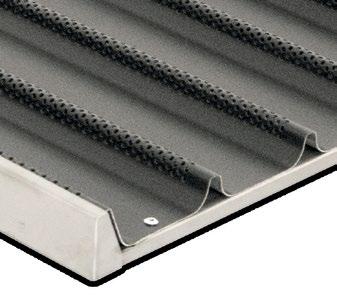


06 18 www.bakingbiscuit.com iba 2018 A new instore baking process Interview iba from the US perspective Production Fully automatic pizza press BAKING STORAGE PROOFING BAKING STORAGE PROOFING

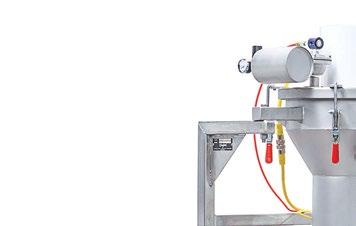







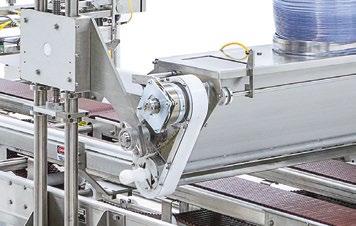


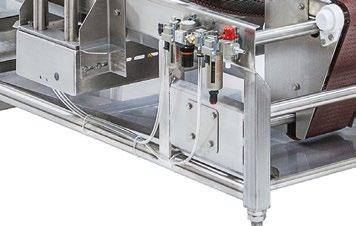
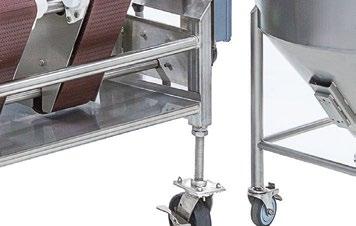
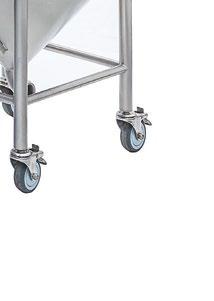





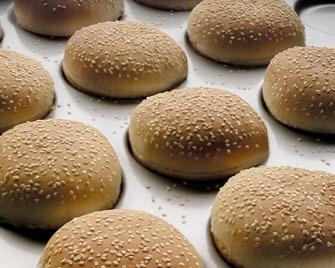
Right hand model 9840 shown with optional water spray, stacked water splitter, conveyor and MPA auto fill system. SMART SEEDER CALL US TODAY +44 1638 668563 THE TOPPING EXPERTS P.O. Box 748 • Maysville, OK 73057• Telephone (405) 867-4467 • Fax (405) 867-4219 • e-mail: sales@burford.com www.burford.com Unit 4 Sam Alper Court, Depot Road, Newmarket, Suffolk CB8 0GS UK • +44 1638 668563 • e-mail: sales@burford.com
Only a few weeks have passed by since the IBA 2018 in Munich closed its doors. The impressions we were able to take with us from the IBA are still fresh in our mind. This trade fair managed to surpass even what was expected of it. It was a successful mixture of the “must haves” that are needed in everyday factory operation with a presentation of the many macro- and micro-trends that were brought close to the specialist visitors. The future was there to be seen.
++ Armin Juncker Chief Executive Verband Deutscher Großbäckereien e.V. and Treasurer and thus a member of the Executive Board of the AIBI (International Association of Plant Bakers)

There were two particularly unmistakable and conspicuous trends in this respect, and which we will certainly meet again day after day in the business, as well as at the next IBA trade fair: the trend towards automation, whether in the form of perfected mechanisms or in state-of-the-art electronics. In contrast to visitors’ comments one could sometimes read, automation is not only of interest for the industry but is also already a part of the future for artisans. The second trend is the orientation towards premium-quality baked goods and services.

The interest and premium offerings are overwhelming. The sector is trying to show what it is capable of, and it is helped in this respect by the fact that suppliers have also begun to conquer new ground. The slogan already coined by a well-known major Munich bakery many years ago: “Maximum quality at acceptable costs, rather than minimum costs with acceptable quality,” was almost palpable.
Consequently, everything was available: from a sound assortment at entry level prices to the equipment for high-priced luxury baked products. Our sector has the power to contribute decisively to a healthy, enjoyable diet in the future as well, no matter what reformulating that involves.
The IBA was a highly informative performance show. The conference of the International Association of Plant Bakeries (AIBI) in the spring of 2019 will link to it almost seamlessly. In richly traditional Manchester, there will again be an opportunity to glimpse the future of baking under the Congress motto: “The Bakery of the Future”.
Yours sincerely,
 Armin Juncker
Armin Juncker
EDITORIAL
Premium
ADVERTISEMENT PosiDrive Spiral™ • High Tension • Heavy Loads • Greasy Products • Product Movement Proven Solution For: Call for System Audit +31 20 581 3220 www.ashworth.com
PUBLISHING COMPANY
f2m food multimedia gmbh Ehrenbergstr. 33
22767 Hamburg, Germany
+49 40 39 90 12 27 www.foodmultimedia.de
PUBLISHER
Hildegard M. Keil
+49 40 380 94 82 keil@foodmultimedia.de
EDITOR-IN-CHIEF
Bastian Borchfeld
+49 40 39 90 12 28 borchfeld@foodmultimedia.de

EDITORIAL STAFF
Helga Baumfalk +49 40 39 60 30 61 baumfalk@foodmultimedia.de
ADVERTISING DEPT.
International sales director Dirk Dixon +44 14 35 87 20 09 dixon@foodmultimedia.de
Advertisement administration
Wilfried Krause +49 40 38 61 67 94 krause@foodmultimedia.de
DISTRIBUTION
+49 40 39 90 12 27 vertrieb@foodmultimedia.de

TRANSLATION
Skript Fachübersetzungen Gerd Röser info@skript-translations.de

TYPESETTING
LANDMAGD in der Heide Linda Langhagen; design@landmagd.de
PRINTED BY Leinebergland Druck GmbH & Co. KG Industriestr. 2a, 31061 Alfeld (Leine), Germany
BAKING+BISCUIT INTERNATIONAL is published six times a year. Single copies may be purchased for EUR 15.– per copy. Subscription rates are EUR 75.– for one year. Students (with valid certification of student status) will pay EUR 40.– (all rates including postage and handling, but without VAT).
Cancellation of subscription must be presented three month prior to the end of the subscription period in writing to the publishing company. Address subscriptions to the above stated distribution department.
No claims will be accepted for not received or lost copies due to reasons being outside the responsibility of the publishing company. This magazine, including all articles and illustrations, is copyright protected. Any utilization beyond the tight limit set by the copyright act is subject to the publisher’s approval.
Online dispute resolution in accordance with Article 14 Para. 1 of the ODR-VO (European Online Dispute Resolution Regulation): The European Commission provides a platform for Online Dispute Resolution (OS), which you can find at http://ec.europa.eu/consumers/odr
Valid advertising price list: 2018
www.bakingbiscuit.com 06/2018 CONTENT 04 IMPRINT
cover
© xxx cover
© Diane © karandaev –123rf.com © cetravac 20 34 Production 34 MCS: Fully automatic – but with a touch of craftsmanship 42 Rademaker: Secondary virtues are in demand 46 Boulangerie Pain: Absolute artisan skill 54 GoodMills: Less flour dust in the bakery iba special 08 The trade fair 10 Robb MacKie: “It has been phenomenal” 16 Automation and digitalization: Who will be the technology leader? 18 Kaak: “Baker’s fingers” 20 Cetravac: A new instore baking process 22 W&P: Dividing and moulding competence 24 FRITSCH: Intelligent services 26 Kövy: Optimizing roll production 28 Slicing technology 30 Kempf: Durable coating Market 38 Online sales: The logjam has broken 44 PLMA: Private labels have big shares 50 Rützler: New food culture trends Packaging 58 Ishida: Fast, compact and flexible Product planning 60 CSB: Good planning is half the battle Regulars 03 Editorial 05 News 17 Trade fair calendar 32 News 36 News 56 News 62 News © ABA 10
photo:
photo:
Fritsch: Alexander Schmitz becomes new Managing Director
During a press conference at the iba, Klaus Fritsch, Chairman of the Supervisory Board of the Fritsch Group, announced that Alexander Schmitz (50) would take over as Managing Director on January 1, 2019. The mechanical engineer has worked for Bosch for many years, including in the field of packaging systems. +++
++ RBS Announces the passing of Thomas (Tom) Lugar

Thomas (Tom) Riley Lugar, former President of Thomas L. Green & Co., Inc., a manufacturer of biscuit and cracker baking equipment, has passed away. Tom joined his family business, Thomas L. Green & Co., Inc., founded by his grandfather, in 1957 and served as President for more than 50 years. The company became a division of Reading Bakery Systems (RBS) in 2001 and Tom remained active until shortly before his passing. Within the industry, he served as treasurer for the Cookie & Snack Bakers Assn. for more than 40 years and was active within the Biscuit & Cracker Manufacturers Assn. Tom passed away on August 9 at his home in Indianapolis. +++
++ RBS Announces the passing of Vince Pasquini
Reading Bakery Systems (RBS) announces the passing of Vince Pasquini. Vince began his long and distinguished career at RBS in 1993. He held positions of increasing responsibility including Design Engineer, Project Manager and Pretzel & Snack Technical Sales Specialist. His remarkable ability to envision mechanical solutions for the most challenging applications enabled him to excel at machinery design. He created the foundation of many of the machine designs used in the current RBS product line. Vince earned his Mechanical Engineering degree at Penn States University. Before coming to RBS, he worked at Edco, a machinery design firm. While
++ Tromp Group announces President’s departure
Tromp Group announced the departure of Richard van Heukelum, President of the Tromp Group, as of August 21, 2018. “Over the past few years, Richard has been an integral part of Tromp Group’s success. We greatly appreciate Richard’s contributions during his time with the Tromp Group. We wish him continued success in his future endeavors.” stated Markel Food Group CEO Ken Newsome. +++
++ Fabiano Malara appointed General Manager
Tromp Group announced the appointment of Fabiano Malara as Vice President and General Manager at September 10, 2018.

“We are excited to have Fabiano on board.
Fabiano is a strong leader and Certified Master in Lean disciplines.” stated Markel Food Group CEO Ken Newsome. “I am excited about Tromp Group,” stated Mr. Malara. “When I see the convergence in
working there he designed a pretzel cutter for a local pretzel company, and this design got the attention of RBS. Vince passed away on August 17, 2018. +++
++ Klavs Berzins appointed Managing Director of Fazer Bakery Baltic
Klavs Berzins has been appointed Managing Director of Fazer Bakery Baltic and member of the Fazer Bakery Business Area management team. The Fazer Bakery Baltic business unit was established in 2014 by uniting Fazer’s bakery businesses in three countries - Estonia, Latvia and Lithuania. Fazer has operated in Estonia since 1993, and in Latvia and Lithuania since 2001. Currently Fazer Bakery Baltic employs over 620 people. +++
ProSweets Cologne: On the pulse of the market situation
ProSweets Cologne offers the complete range of supplies for the sweets and snacks industry: from innovative ingredients to pioneering packing solutions, and through to optimized production technologies. In conjunction with ISM, the world's leading trade fair for sweets and snacks, ProSweets Cologne covers the industry’s entire value chain. From 27 to 30 January 2019 the trade fair duo is placed once again in the industry's focus. In total, over 300 companies from the manufacturing, packing and ingredients sectors are expected in Cologne. ProSweets Cologne is accompanied by an extensive event program, which includes for instance expert lectures in the “Speakers Corner” as well as diverse special events on the themes of newcomers, ingredients and packaging. +++

technologies with Tromp Group and AMF, the market potential is significant.“ Newsome added, “Fabiano is an example of a leader of the future in the industry. He brings passion and a customer focus plus skills and knowledge from being a leader at Danaher and Phillips.” +++
++ Hans Herman Doude appointed Vice President Marketing & Sales
The Tromp Group announced the appointment of Hans Herman Doude as Vice President Marketing & Sales as of October 4, 2018. “With his many years of great Industrial experience at WP Kemper and his International experience, he will lead the Marketing & Sales department. Hans Herman will lead the Tromp Group and AMF Sales teams in Europe, Middle East and China,” stated Markel Food Group CEO Ken Newsome. +++

++
05 NEWS ++ NEWS ++ NEWS www.bakingbiscuit.com 06/2018
©
©
©
Tromp Group
Tromp Group
RBS
The Future of Science –
















Summary: Innovations have many fathers and mothers








Science: Highlights for the baking industry – What the scientists are currently working on Round Table: Leading production managers discussed the future of bakery production Market View: Mixing + Kneading, Dough Processing, Ovens, Cooling + Freezing Company Reports: Profiles of 26 major suppliers to the bakery market





– Technology
Technique
++ Brand new! ++ thermal energy for the baking process. Practical advantages of VCB technology are well documented in the literature, especially regarding the high temperature applications often investigated at LSTM in the past, e.g. VCB applications in the glass or aluminum melting industry, gas turbines, paper dryers, boilers or fuel cells. On the other side, in order to apply this technology in the low-temperature processes, as sensitive as bread baking, new baking oven concept was proposed, developed and tested within this work, from purely theoretical consideration up to the fully functional prototype in the industrial scale. Motivation in numbers Continuous growth of population, further industrialization and technology oriented life style, are leading toward both a further global energy demand growth and continuous increase in the food demand. International Energy Agency (IEA) estimates that the energy demand will grow by more than one-third over the period up to 2035 [1]. Today most of the world total primary energy supplies (over 81 %), comes in of fossil fuels and additional 10 % in the form of renewable – bio fuels [2]. Study published by the U.S. Department of Energy (DOE), estimates that fossil fuels will continue to satisfy almost 80 % of the world energy demand until 2040. Furthermore, DOE estimates a pronounced global shift away from the use of oil and coal toward the use of natural gas and renewables in the period 2010-2040, with the natural gas as the fastest-growing fossil fuel in the outlook, with global consumption increase of 1.7 % per year [3]. In the Federal Republic of Germany, the primary energy demand has the similar structure, where around 80 % of primary energy requirements are provided by the combustion of fossil fuels [4]. According to the Federal Statistical Office of Germany, the food industry is at the sixth place in the list of the most energy-intensive industrial branches, with the annual energy demand 75 % higher than for example German automotive industry [5]. On the other hand, analysis of the German bread market shows two major tendencies, i.e. the production centralization and an increase of the annual turnover. In their report from 2016, Association of German Bakeries e.V. reports that the number of bakeries in Germany has been continuously reduced from over 20,000 in the year 2000, to 12,550 in the year 2015 [6]. In the same time, the number of Bake-Off-Station in Supermarkets and Self-Service-Bakery increases (industrial production), as well as the total turnover which increased from 15.7 billion year 2000 up to 19.5 billion € in the year 2015 [6]. That practically means that in average, more than 460 bakeries are closed every year, while in the same time the average turnover increases for more than 235 million €/year. It becomes more difficult to stay competitive in such a market situation, especially for small and middle size bakeries. Therefore is the continuous reduction of the production costs through the reduction of the energy requirement in the production sector, possibility to adjust fast to new products and/or shortening of the production time essential for ever producer, independent of its size and annual turnover. The energy demand for the production of bread and baked goods can reach values up to 4.8 MJ/kg, from which only one third is effectively used for heating the baked goods. Cited inefficiency and the high energy demand affect especially small and medium-size companies (SME). Accordingly, baking industry has an acute need for innovations that increase the energy efficiency, reduce the required baking time and other improvements of production ecology and economy, while securing the baked goods quality. In this way the designed baking oven offers advantages especially for SME, which are characterized by variety of products and variable production load. Our goal This work was based on the assumption that the VCB-based baking oven technology can profit from the previously known advantages of the VCB technology in general, i.e. high thermal radiation output, broad modulation range, excellent dynamic + The energy demand in the production of high quality food products is and always was generally significant. The food industry is therefore commonly among top ten or even among top five most energy demanding industrial branches. This results in constant need to improve existing technologies or to introduce novel ones, which is oft significant ecological and economical challenge. In the case of food industry, additional challenge is that improvement or replacement of existing technologies must not compromise neither food quality nor its safety. That means that many of the novel technologies and solutions, commonly applied in other industrial branches, cannot be simply transferred to the food industry. Exactly this kind of technology transfer of the relatively young VCB combustion technology from high to low temperature application was in the focus of interests in the research project AiF 17735 N. Research was recently done by the scientific teams of Prof. Antonio Delgado, Institute of Fluid Mechanics (LSTM) at FriedrichAlexander University (FAU) in Erlangen and Prof. Thomas Becker, Chair of Brewing and Beverage Technology at the Technical University in Munich (TUM), together with the industrial partners supporting this project. The core of the novel baking oven concept is the use of the porous volumetric ceramic burner (VCB) as the alternative, highly radiative source of the VCB based baking oven concept –efficient, innovative and flexible Experience gained in the high temperature applications, enables the use of the porous volumetric ceramic burner (VCB) technology for the food production and opens a wide spectrum of new, economically and ecologically attractive, possibilities. Jovicic EMERGING TECHNOLOGY SCIENCE EMERGING TECHNOLOGY SCIENCE 10 + In joining forces, the two industry leaders are collaborating in the development, sale and distribution of 3D printers. The initial launch will take place in the U.S. in 2019 with potential to expand into Europe in 2020. “We are very excited about what this opportunity can mean for the food industry,” said CSM’s President and CEO Marianne Kirkegaard. “Our agreement with 3D Systems has the potential to re-shape the food industry,” she said. “Across a number of industries, 3D printing has helped transform industries and there’s every reason to think the same can be true for the food industry. We are looking forward to partner with 3D Systems, the company that invented 3D printing, and continue to expand capabilities and opportunities in the culinary market with their platform.” Vyomesh Joshi, 3D Systems President and CEO, expressed similar optimism about the agreement. “Our extensive and versatile portfolio of materials addresses the widest range of applications and performance in 3D printing – from culinary to industrial,” he said. “As we continue to drive innovation and explore strategic partnerships with industry leaders, our partnership with CSM is a perfect fit to leverage our technology and capabilities to expand applications and materials.” 3D CRAFTED DECORATION Shaping the Future CSM Bakery Solutions and 3D Systems are working together to transform the world of culinary art with the first commercial-grade 3D food printer. With CSM as experts in the bakery arena, and 3D Systems as experts in the printing arena, this is a great opportunity to contribute to the future of the food industry as a whole. 3D printing is already used successfully in many industries and we have great confidence that 3D technology can be used efficiently in food. This opportunity creates world of possibilities. For now, we will start with what we know best, sugar, and see where it takes 3D printing allows the creation of highly complex shapes and designs in relatively short time with limited effort; and, in many cases, these printed products can be replicated to create many items at once. 3D Printing Technologies At this moment there are number of general 3D printing technologies available in the market: + Extrusion + Light Polymerization + Laminating + Wiring Powder Bed As we explore these technologies we see three as most feasible to be used edible material: Extrusion – Fused Depositing Modeling A defined process in which material is joined solidified to create a 3-dimensional model by adding the material together layer by layer until the object is finished. Printing CSM Bakery Solutions b d e Systems Solutions Systems Solutions 3D FOOD PRINTING 19 SCIENCE 3D FOOD PRINTING SCIENCE Stammen: The speed of the changes has altered. Things we do today may possibly still be valid tomorrow, but already out of date on the day after. This involves not only processes, but also products and the half-life of knowledge. Another point is the requirement for transparency, which I notice every day. At the process level we must know what is happening, and when and where it is happening. Industry 4.0 supplies many data sets for this, but how do we turn them into relevant information? In my world, it is impossible to draw any real distinction between costs and quality leadership, since costs constitute a part of quality and vice versa. That’s why having cost transparency is a good thing, to enable an explicit examination of customers’ demands in conjunction with the knowledge about quality requirements. Customers’ wishes and the product being offered must match at all points. Keil: Up to now you have all talked about the changed demands placed on you by the market in widest sense. But what was the situation in engineering and technology; were there any groundbreaking innovations in that area? Lötz: As said, the cleanroom. + Schirmer: And lamination technology and dough sheeters also emerged in this period. + Stollmeier: One current revolution is certainly vacuum cooling. They exist in few bakeries as batch coolers, and are increasingly appearing in the industry. was already able to look at continuous plant for fresh bread in Spain couple of years ago, which was very interesting. Keil: What does the position regarding continuous mixing look like? Stollmeier: Continuous mixers are rarely good for quality ... Lötz: I don’t agree – it’s question of what my requirements are, and for which product. For few products, what matters is a continuous supply of dough. Batch mixers are rather a disadvantage in that case, and continuity of dough supply must be rated much higher in qualitative terms. + Schirmer: The fear of continuous mixing is also derived more from the fear of being restricted by it. It makes fast, flexible product changeover more difficult and needs high level of specialist knowledge. Sehnert: There’s nothing better for the continuous production of pretzels with a defined weight. Schirmer: Has there ever been well-known mixer manufacturer who worked actively on researching and developing continuous mixers? Most batch mixer producers show no great interest in making flexible continuous mixer ready for the market. Lötz: Innovation is driven not only by the machine builders but also by ourselves as users. Our needs for targeted solutions are what bring forward. Of course at the time we are ones who are driven. customers want very specific product with particular properties, we must devise the plant and set up the processes in such way that they create the corresponding products according to the customer’s requirement. + Stollmeier: Nowadays, we no longer adapt any dough to the plant. No more quality compromises are made today. Not in relation to energy consumption either. Borchfeld: Energy efficiency as an investment criterion is an issue; what is current situation regarding a comprehensive energy concept for plants or production facilities? But quality and safety/security management have also changed very significantly in the past twenty years, not just line technology. + Conen: Operating a line without baker would have been unimaginable twenty years ago. That is now possible even with non-specialist staff. The decisive employees nowadays are those that can handle a PC and the control system, regardless of whether they were trained as bakers. Today, specialist knowledge must be put into the controller and programming by middle management. Stollmeier: have the good fortune that can look back over 34 years, and for me the most important development has taken place in production safety. 34 years ago, there were practically no laboratory checks or metal detectors in any bakery. Both are now standard practice, and we are now talking about X-ray equipment for foreign body monitoring. Again in my view, the second big change was the introduction of frozen products, with which at first there was competition with classical artisan bakers. Quality standards are significantly higher nowadays. They are complied with mainly by modified processes, with sponge doughs and sourdoughs, long dough management times etc. In my opinion, the Industry 4.0 topic already exists in the areas of silos, sourdough preparation and the whole of raw materials management. It has merely been talked about in the make-up area up to now. + Schirmer: The emergence of bake-shops has changed production in the industry. Anyone who offers par-baked nowadays must achieve high level of quality to ensure that the quality attained after instore baking withstands any comparison with freshly-baked products. TABLE ROUND TABLE ROUND ROUND TABLE 88 + manufacture of bread fermented goods, whatever the scale, requires the use of significant quantities of increasingly expensive energy. Around 60% of energy used in bread manufacture associated with the conversion dough to bread in the oven. Reducing energy requirements in a bakery is not simply case of shortening the baking time or using a lower oven temperature as is the interaction between the dough and the conditions in the oven that does much to decide what the final products qualities will be. The transition of dough to bread during baking (and batter to cake) is complex and described by cereal technologists as being a ‘foam to sponge conversion’; the ‘foam’ being the dough and the ‘sponge’ the structure of the baked loaf (Cauvain, 2015). Foams are characterised by having lots of small gas bubbles trapped in matrix and this is case with bread dough (and cake batter). The trapped gas bubbles will be expanded by the carbon dioxide gas coming from yeast fermentation (baking powder in the case of cakes). In the oven the setting of the structure by heat bursts the gas bubbles and a rigid, open structure is created – the ‘sponge’ (the term is used in the generic rather than specific sense. The impact of heat input in the oven is important but the factors which are most critical are those which been built into the dough (foam) before it reaches the oven. This means that most of the product qualities and to significant extent, opportunities for process and energy efficiency are associated with dough mixing and processing. Mixing Understanding the basis of bread quality can be likened to building a house (Figure 1). You start with the foundations recognising the value of having strong base on which to build the frame of the house. The development of a suitable gluten network is the foundation of breadmaking and Improving the processing of dough to bread Most of the product qualities and to a significant extent, opportunities for process and energy efficiency are associated with dough mixing and processing. comes from the hydration of the wheat flour proteins and the input of mixing energy. Gluten development requires the input of energy even if the dough is mixed by hand. In most breadmaking process, mechanical means are used to input energy and the main control of the process is by time; longer mixing equals a greater energy input. Some breadmaking processes, for example the Chorleywood Bread Process (Cauvain and Young, 2006) mix to a fixed energy input. The friction between the developing dough and the mixer impeller blades can be examined using the energy graph generated during the mixing process. An example of such a mixing curve is illustrated in Figure 2. At the start of mixing there is little resistance from the ingredient mixture but as the gluten network begins to develop, dough resistance increases and the graph begins to rise reaching a maximum value before slightly falling before the end of mixing. Keen-eyed readers will note the similarity of the curve shape to that of the Brabender® Farinograph and similar laboratory test equipment used for the assessment of flour quality (Cauvain, 2018). A key difference however, is that the curve in Figure comes from an industrial mixer with full recipe and faster mixing speed than commonly used with Farinograph testing. Further the illustration in Figure 2 also includes a physical change part-way through the mixing (the application of partial vacuum) with corresponding change in the shape of the curve. Few bakers think to interrogate mixer performance using such data but at BakeTran we have used this approach to explain why apparently ‘identically set-up’ mixers (baker’s description) deliver slightly differing bread qualities. Through the detailed examination of mixing data it is possible to reduce unwanted variability in bread quality. Controlling final dough temperature Along with the input of energy during mixing comes the inescapable generation of heat, so that the final dough temperature is greater than the weighted average of the ingredients at the start of mixing. The control of final dough temperature is the most critical control point of bread quality in the bakery and key to process efficiency. Control of the dough temperature coming from the mixer should be a ‘simple’ case of optimising energy input during mixing; once that is achieved then the temperature rise factor will be constant and variations in flour temperature can be compensated by adjusting the input water temperature. This is process control in baking at its most basic. In some cases achieving low enough water temperature may require the addition of part of the ‘liquid’ as ice or chilled saline solution (making use of the fact that salt lower the freezing point of water). Using ice provides practical way of controlling final dough temperature but may 2 PLC reading Mixing conditions changed Mixing time (sec) 2.50 0.00 BakeTran Ingredients which improve gas retention (improvers) Carbon dioxide production by yeast to inflate bubbles bubble nuclei AA Oxidation of the gluten Roof Foundations Oxygen Flour protein hydration and development of gluten network Work input in mixing Control of dough temperature House of ‘Bread Quality’ Example energy curve from commercial dough mixer SPITZMARKE SCIENCE 36 PROCESS INNOVATIONS SCIENCE PROCESS INNOVATIONS hygiene-friendly and easier to clean. There are also no longer any dry running problems with these pumps. A plant cooperation with the Handtmann dough divider is also new. A combination of dough preparation by the Codos with the dough divider is currently being tested in the Dough Technology Center for bread and toast-bread as or as four pieces, as well as via a special molding method for buns. Bühler’s machine construction group also “entered the ring” in 2017 with a continuous mixer. Its JetMix continuous mixer can be used both to hydrate raw materials and to produce all kinds of sponge doughs. Up to now, models with an hourly capacity of tons are available as a standalone version for sponge dough production. When mounted directly on a tank, the system achieves an output capacity of up to 3.5 tons/ hour. In addition to the JetMix, Bühler also showed its sponge dough and sourdough solutions for industrial baked goods production for the first time last year. Installation of pilot plant for technologies relating to dry and wet raw materials is also planned in the near future, to allow the complete materials handling process to be demonstrated. Dough extruder has added the ContiMix dough extruder to expand its range of plants for industrial bakeries. The continuously operating twin-shaft extruder combines two decisive processes: mixing the ingredients and kneading the dough. The plant is suitable for preparing consistent doughs for laminated products, e.g. puff pastry dough, flat products such as pizza dough and shaped products like breads toast-breads. The ContiMix also has recipe-controlled metering system for dry and liquid ingredients, zones for vacuum or pressure treating the doughs, a cooling zone and easily interchangeable extruder shaft modules. Bühler says this allows fast configuration of the new dough extruder to the required dough specifications exactly according to the recipes. According to a company statement, baked products manufactured using the ContiMix above all in the case of laminated products, show improved volume and crumb structure, and are said to have more intense flavor. Finally, it goes on to say that the continuous process allows an additional dough rest and the associated dough handling to be omitted. The dough immediately goes forward to the next production phase, which decisively shortens the entire production time. Orientation towards sponge dough The French company VMI has also been among the suppliers of continuous mixing systems for many years. Its VERYMIX continuous kneader or the CONTINUUM, the latest patented continuous mixer boasting vacuum capabilities, are specifically adapted to spongy products such as sandwich or buns. + Anyone who believes bakery technology is so mature that there can never be any more big changes and innovations is mistaken. Customers’ requirements have again changed enormously, especially in the past three to five years. The demand is not only for more efficiency and cost savings but also for better operability, more hygiene, more control options, and in many cases more flexibility as well. The baking sector is compelled to adjust to fewer and less qualified staff, and that has repercussions on machine constructors. The editorial staff of baking+biscuit international have summarized the most important changes in machine construction, although without making any claim to completeness. It is both a retrospective review and a prospective outlook, and shows which opportunities are open to the sector. Continuous dough preparation Zeppelin’s advanced developments include a combination of a DymoMix and Codos continuous mixer. The DymoMix wets free-falling solids with water or yeast solution, while inputting energy at the same time. According to Zeppelin, the “precursor stage” produced in this way reduces the mixing time with conventional batch mixer up to 30%, and achieves up to 2% increase in water uptake by the flour. The mix leaving the Dymomix is metered either directly into the Codos mixer or into an appropriate container for further fermentation. To discharge the pre-dough, the previous progressive cavity pumps are replaced by double screw spindle pumps, because the latter consist entirely of stainless steel and are thus more
left: JetMix of Bühler can be used to hydrate all kinds of raw materials produce sponge doughs of all types right: The DymoMix of Zeppelin is positioned directly conti-mixer The twin-shaft Bühler zones for treating the dough vacuum or pressure Continuum kneader is specifically designed for the sandwich bread, buns spongy product industry f2m MARKET 107 TECHNOLOGY MARKET TECHNOLOGY Rüdiger Stollmeier, Project Manager, Europol S.A. Norbert Lötz, Managing Directo Production and Engineering Harry Brot GmbH We need know-how in our own organization Those responsible for production in the Austrian, German and Polish baking industries met in Hamburg in late May. At f2m’s invitation, they discussed the current state and future of bakery production. Mario Jekle, of the Cereals Technology Research Group München Franz-Josef Managing Director Bonback Silvio Steinert, Managing Director Kronenbrot Axel Technical Managing Director Markus Stammen, Managing Director, Production, Supply Chain, IT, Rudolf Ölz Meisterbäcker & Co KG Markus Schirmer, Managing Director GmbH Bilder der Diskussionsrunde
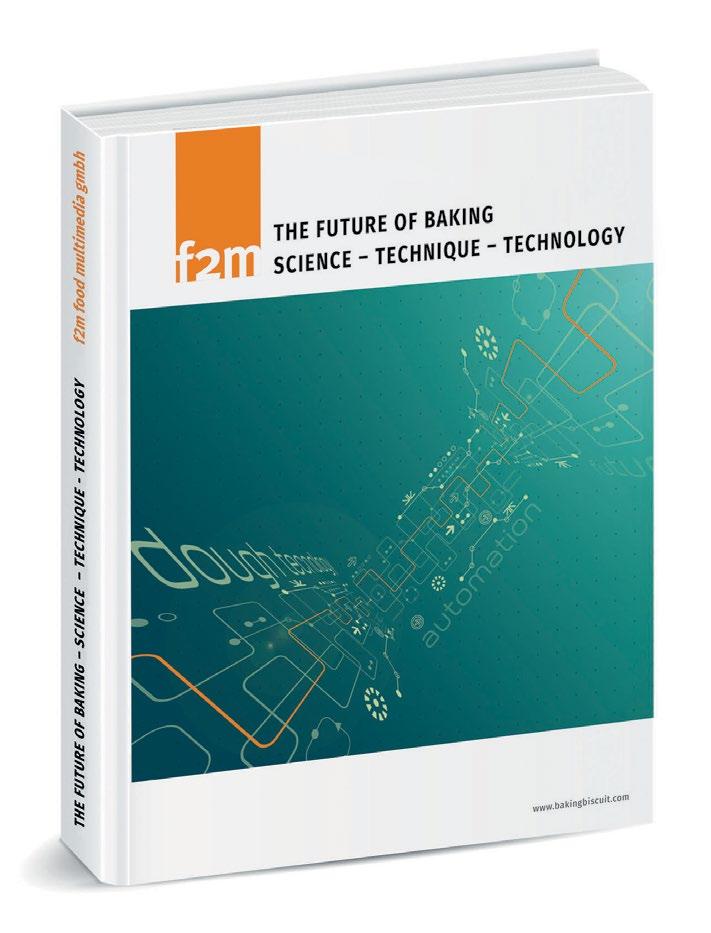











Baking Technology f2m food multimedia gmbh – Ehrenbergstr. 33 – Hamburg – Germany – info@foodmultimedia.de Phone: +49 40 39901227 – Fax +49 40 39 90 12 29 – www.foodmultimedia.de Order now! Hard copy • 208 pages EUR 45 incl. VAT + delivery costs www.backwelt.de/the-future-of-baking.html Also available as USB stick.











IBA 08
The trade fair



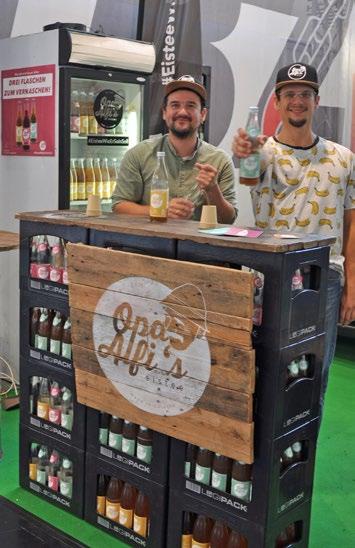



The iba is quite simply the trade fair for the international bakery sector. National and international bakery business representatives were already obtaining information from exhibitors on the first day of the fair – all very targeted and focused. The visitor stream observed by the f2m team didn’t dry up until the last day of the fair. The overall mood can be described as good to very good – among both visitors and exhibitors. Raw materials suppliers and plant builders showed that companies had tackled many issues. In addition to new developments, however, exhibitors also presented further developments of existing machines, together with interesting ideas for production – the keywords here being automation and digitalization. The f2m team was on the move in search of innovations almost without interruption during the entire trade fair. The editorial office had already organized a number of topics, as can be seen on the following pages. And we are continuing to work to inform our readers with commentaries and reports in forthcoming issues of our publications. +++


09 IBA
“It has been phenomenal”
At the 2018 IBA in Munich, baking+biscuit international was able to sit down with Robb MacKie , American Bakers Association (ABA) President & CEO.
bbi: What is your impression of IBA 2018 here in Munich?
+ MacKie: It is a Wow. The innovation and new products has been phenomenal. I think what is interesting is that the crowd is strong, but I’m sensing and seeing more serious buying going on than maybe in the past. I can tell you from the US perspective that we have about 60% of our ABA Board of Directors here, so the major US commercial baking companies are here. Many of our supplier members are also here including the equipment, yeast, and other ingredient companies, but not so much on packaging. Anybody that has an international presence on the supplier side is here. There are so many here that I am struggling to get around to see everybody.
+ bbi: What do you think is the most important difference between IBA and the International Baking Industry Exposition (IBIE) in Las Vegas?
+ MacKie: I think IBA is a great show, as a more traditional trade show. Always with the latest innovation in equipment, ingredients, and processes. The difference between IBA and IBIE is that education is a bigger component at IBIE. The demand for education is so great that in addition to the morning educational programming, we added another day of education at the beginning and we have had no trouble filling those spots. All the education sessions are designed as part of a multi-faceted, multi-track education programing. There will be on floor sessions and hands-on demonstrations. There will also be content on efficient management and energy management for the larger commercial bakers. There will be different segments, including sweet goods, bread, artisan bread, covered very heavily. In my mind, education is the biggest difference. We have been doing a lot of international delegation meetings talking about IBIE. In every single one of those meetings, regardless of the country we met with, the desire for training and education has been front and center.
+ bbi: Which innovation impressed you most at IBA?
+ MacKie: It is hard to pick one thing. There are just little things here and there. Some of the ingredient companies in the craft and artisan space have really stepped up their game at this show. I would say there are a couple of things in the packaging space that are what I would consider a nontraditional baking packaging that would allow for instance a sandwich offering that would preserve freshness without having soggy bread. Some of those vacuum packaging systems have also been really interesting. The robotics is always neat and cool. The IBA Virtual Reality session was also very impressive. There is a company that is doing steam doughnuts, so instead of putting the doughnut into a fryer with the fat and other issues they are baking it with steam. I don’t know if it is applicable to a high speed, high volume operation.
Robb MacKie is the President and CEO of the American Bakers Association (ABA). He previously served for 11 years as Vice President of Government Relations. The ABA is a trade association representing the interests of the $102 billion wholesale baking industry in Washington, D.C.


Mr. MacKie previously served on the steering committees of several issue-oriented coalitions including co-chairing the National Coalition on Ergonomics and the Food Industry Coalition on Hours of Service Regulations. Before joining ABA, Mr. MacKie worked for a Congressman and Trade Associations.
Mr. MacKie provides strategic guidance as a member of the Kansas State University Grain Sciences Program Advisory Committee. In addition, he serves on the Board of Directors of BIPAC’s Prosperity Fund and the US Chamber of Commerce’s prestigious Committee of 100. MacKie is a graduate of Frostburg State University with a degree in Political Science.
www.bakingbiscuit.com 06/2018 IBA 10
+
Robb MacKie
Source: www.americanbakers.org © ABA
Doughnuts sell like crazy anyway, but if you can offer a doughnut that was as high quality with less fat and less calories, that would be huge. A couple of bakers have whispered to me that they have seen it.
+ bbi: Do you think it is worth for an American baker to visit Munich IBA?
+ MacKie: Yes, absolutely. Our participation has grown over the last three shows and I give a lot of credit to Joe Turano from Turano Baking Company who is the IBIE 2019 Chairman, as well as to Erin Sharp from The Kroger Company and ABA Chair of the Board of Directors. They made a big appeal to all of the American bakers to come and participate. We have probably more first time US commercial bakers attending IBA than we have ever had, and it is because of their leadership. The bakers have been really blown away. We have asked them to be ambassadors for IBIE and that is the role they have embraced really well. They have participated in numerous meetings and interviews, Erin Sharp sat in on probably four of the international delegation meetings. The highlight was a joint meeting with our board of directors and the board of directors for AIBI, which is our counterpart organization for the EU, and it was a very productive conversation. IBA is also a great place to spot trends. For example, two IBAs ago I was with one of our members and he was very interested in the Middle Eastern flatbreads and now has two lines that do nothing but produce Middle Eastern flatbreads and they have been very successful. It is a great place to see many of the different global baking taste and trends and then maybe bringing those over to the United States and adapting them to the US consumer.
+ bbi: Is the IBA show a networking place for you and IBIE?
+ MacKie: Yes, the world is getting smaller and it is really interesting the issues are essentially the same, no matter if it is in developed countries and in Europe or in some of the emerging markets like India and South Africa. The issues include: fad diets, free from diets, wheat quality issues, food safety, all of these issues to differing degrees and different scopes are similar globally.
+ bbi: Do you see a chance for more cooperation between IBA and IBIE?
+ MacKie: Absolutely, we have the same target markets. As we have learned it is not a competitive situation. Speaking from the US Baker perspective, a lot of the US bakers will come to IBA to talk to an equipment company or an ingredient company. They will come here with a challenge they are trying to solve, or they are thinking about a new product, or a new process and then next year they will be ready to make the purchase or vice versa. We are having conversations about an even closer collaboration.
+ bbi: Why should European Bakers come to visit IBIE in Las Vegas? Other than going to Las Vegas?
+ MacKie: Las Vegas is a big draw. I also think these are the two shows that the serious buyer can come and spend time in a
++ Since 1897, ABA has represented the interests of bakers before the U.S. Congress, federal agencies, and international regulatory authorities. ABA advocates on behalf of more than 1,000 baking facilities and baking company suppliers

meaningful way. It is an opportunity to see, even in just a year, what innovation is out there. It is not consumer electronics with a revolutionary new product every 6 months, but the baking technology is turning faster. We notice especially in the sustainability and sanitation areas. It is also another opportunity to network with their global baking peers, IBA and IBIE provide that opportunity, we get a lot of positive reaction from the European bakers. If you look at a lot of the exhibitors here you are going to see the exact same exhibitors at IBIE. It is also an opportunity for those who could not make it to IBA to see many of the exhibitors that they missed.
+ bbi: When walking around you see some key words at several booths. One of them is automation. Is it important for the United States’ process automation?
+ MacKie: Yes, absolutely, especially now with the United States approaching record low unemployment and the number one issue and challenge facing the US bakers is access to skilled, talented employees. I think in Europe and in the EU particularly they have been through that situation. What we are seeing here is interesting because some of the new equipment and new process automation makes it easier to be used. The goal of buying a highly automated piece of equipment used to be to lower cost by reducing employees, but now every single one of those employees will be retrained in a different part of the baking process. The ROI equation for a piece of equipment has changed, and then that allows them to specialize and retrain the existing workforce and maybe attract a different workforce. I think that it is a needed and necessary development, whether we like it or not. I think this is an opportunity to start thinking about that.
+ bbi: Another keyword is data mining and data analysis to achieve a higher level of quality or higher level of efficiency as well?
+ MacKie: Yes, absolutely a huge issue in the United States. In the US there is a lot of conversation around big data. We can collect all kinds of data. For instance, I was talking to a couple of exhibitors who, like with your automobile, have added capability to do equipment diagnostics through a cell
11 IBA www.bakingbiscuit.com 06/2018
phone app. My first car I could do all the maintenance on it, because it didn’t have any on-board electronics Now you can plug your cellphone into your car and do diagnostics. It is similar with the baking equipment, I have talked to two suppliers here, where you can go walk with your phone and it will connect to a chip inside the equipment that will say the oil lubrication is running low, the bearings are going out, etc. It is the same concept, but saves a tremendous amount on maintenance.
+ bbi: It requires a lot of investment to do these things, a baking line lasts for 20 years or more. Is it a problem to bring it into all these lines?
+ MacKie: It’s a slow process but if I can walk down the line with an iPhone app and see next week we need to do this maintenance now instead of in a month when originally planned, you could avoid a very costly breakdown at the plant. Those unscheduled plant shutdowns due to maintenance activities are so expensive, with the lost product and lost productivity. I think the emphasis on preventive maintenance and the tools that can help bakers do that is very exciting.
+ bbi: What about sanitary design of a manufacturing line?

When you see those lines nowadays, they are high-end.
+ MacKie: High-end, and sometimes a low-tech solution and approach to it, so it does not always have to be the latest technology. In 2007, when the US had a huge food safety issue with the peanut butter recall due to salmonella, we changed our food safety law for the first time in 40 years. As a result, our processes have changed and our association was in the middle through the legislative process and is now on the regulatory compliance side. We also realized as an industry we needed to step up and take ownership and we worked with BEMA (Bakery Equipment Manufacturers & Allied) and AIB (American Institute of Baking) and other partners in the baking space. Now, two times a year, we host sanitation workshops that are specifically designed to look at pieces of equipment and how to change the pieces of equipment and how to improve the sanitation process. That has been enlightening. Our working group who are fanatical about food safety have

commented that even after just two IBAs and two IBIEs, the equipment has changed. It is one thing to get together and talk about sanitary design, but you are actually seeing equipment being changed and there are many examples of that here at IBA. I am impressed how quickly the equipment manufacturers have stepped up. Sometimes it is even a very simple solution with welding and open spaces. No longer can bakers afford to just take a hose and spray all the equipment down, you can’t do that anymore, that creates its own issues. It is too expensive for bakers not to improve the sanitation process. So kudos to the equipment manufacturers for being very responsive on this.
+ bbi: What about waste control and sustainability?
+ MacKie: Controlling waste is right to the bottom line, it’s not always easy but if you can control... Let’s start with the energy side. In the United States we have something called the Energy Star Program, so as an industry we accepted the Energy Star Challenge, which means the bakers are going to reduce their energy usage by 10% within five years. The last time I checked, we had 140 facilities that have participated the challenge. Not all of them are through it yet because it takes some time. I can remember coming to IBA, two IBAs ago, and energy sustainability was a big issue, so I brought that observation back and we challenged the equipment suppliers going to the next IBIE to showcase their energy savings and they responded in a big way. Even though the US is very fortunate to have low cost energy compared to the rest of the world, it still affects the bottom line, if a company can reduce their energy footprint by 10% to 25% then they have more money to invest in other things. The other piece of waste control is packaging waste and including the packaging of incoming ingredients. We have bakers that are moving to zero waste and several that have achieved it. What that means is anything that comes into the facility is recyclable. It is a challenge because in different parts of the country there are different levels of the sophistication with recycling programs. The bakers are working with vendors and any of the plastic that comes in has to be a recycled material as well as working to reduce the amount coming into the
www.bakingbiscuit.com 06/2018 IBA 12
++ The ABA works on well over 50 legislative and regulatory issues
IBA
++ ABA and BEMA* co-founded the International Baking Industry Exposition (IBIE) *BEMA: Bakery Equipment Manufacturers and Allieds
POWER BERRY ARONIA

Life is colourful. Let the unmistakeable intensity of Aronia – nature’s power berry –infuse your assortment with new life and vitality today.
www.backaldrin.com
facility. A baker in the Midwest is working with their flour supplier and has changed the composition of the bulk bags, so now it has natural fibers in it and is much easier to recycle. This zero waste also includes scrap metal being collected and recycled. Often in the US, people do not think of water conservation as a cost driver, but it can affect bottom line. On the ABA website we have a sustainability web page which includes things like checklists and tips and tricks to accomplish that from a practical bottom-line perspective.
+ bbi: Is GMO a big topic in the US?
+ MacKie: Yes, we saw about 20 states pursuing their own GMO labeling programs, and there was a lot of inconsistency. We have one regional baker in the Northeast that covers eight states, all within a couple of hours drive from their bakery and they were going to have four or five different GMO labeling requirements. There is just no way to comply with that, so we were part of a broad coalition in Washington D.C. that said the federal government needs a standard both in terms of defining what is GMO and then how to communicate that to the consumer. How does labeling work, does it have to be on the pack label, can it be a mobile app, maybe it can be some combination thereof. The US Department of Agriculture is working on that right now. As a matter of fact, recently we had the Secretary of Agriculture come and speak to our group. We have provided a comments and feedback with a lot of lowlevel meetings. Some time in November or December we are expecting to get the requirements published for public comment. It is a huge issue. We are about transparency, but we want to make sure that the consumer is educated from a scientific and fact-based information about what it is and what it is not, and then we want common standards around the country. So, if you’re producing product for Rhode Island, one of the smaller States, or California or Texas you would have a common standard to comply with.
+ bbi: What major trends on the US bakery market are coming from product or consumer side?
+ MacKie: No different than what’s going on in Europe, the move towards artisan product is very big, even commercially produced artisan products. We do not have quite the extensive network of small craft bakers that serve multiple retail outlets, we really don’t have that model in the US. There is either a small corner bakery or the large retailers that are distributing products. There are some in between, like a Panera. The American consumer is looking for that artisan, and that craft feel. The other thing that we’re seeing is a move towards denser, more high-moisture breads, more variety breads with a lot of seeds, and high fiber content and even ancient grains. We are also seeing some experimentation in the use of non-traditional grains. I don't know if that’s going to take off or not, but non-traditional flours and alternative flours –I am very curious to see where that goes because some of them have been reported to have healthier components and are supposed to be higher in fiber content or more nutrients. It is very early in this process, but it always comes down to taste quality and functionality for the bakers, but I think
++ ABA members produce bread, rolls, cookies, crackers, bagels, sweet goods, tortillas and many other wholesome, nutritious, baked products. The baking industry generates more than $153 billion in economic activity annually and employs more than 799,500 people
there’s some experimentation going on at a low level right now. Some trend in different product categories, like the indulgence side, is moving towards smaller portions. This allows you to have the same really good traditional product, but the smaller packaged product and label has fewer calories, fat and sugar than buying the full-sized product. I think there is a lot of consciousness around serving size.
+ bbi: Are these trends all over the States or is it trends you can see mostly on the coasts?

+ MacKie: The coasts always drive the trends. A lot of those trends are not in the Midwest yet, maybe except in some of the major urban centers. Generalizing, I think the people in the Midwest are closer to their food as there is a lot more heritage about the agriculture sector, even people who live in a big city like Chicago came off a farm out of Iowa or Nebraska. In general I think there is more connection to food in the Midwest.
+ bbi: Is there a change/exchange between the American Bakers Association and the European baking associations? How does it work?
+ MacKie: We talked a lot about these trends. We talked a lot about government regulations, we talked a lot about food safety. It is interesting because the issues – and they might have a different priority, different scope – but the issues are very similar. What are consumers’ dietary patterns is obviously a big topic, workforce issues is a bit of a different dynamic in Europe but access to skilled talented employees and we find similar issue in the United States. People love the idea of going to work for their little bakery down the street and getting flour on their hands and so there doesn’t seem to be as much a challenge in attracting people to small bakeries, but if you’re doing a larger scale operation it’s very difficult. It is the number one issue facing US Bakers, a top 3 issue facing European Bakers.
+ bbi: Thank you for your time today. +++
www.bakingbiscuit.com 06/2018 IBA 14
Lower Your Cost of Ownership
•Lower Maintenance Cost

•Servo Driven
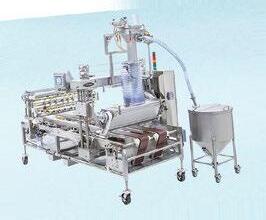


Burford’s seeders, toppers, sifters and pan shakers are a perfect match for our Bun Divider


BUN
LINE
HIGH SPEED
MAKE-UP
•Hygienic Wash-down Design
•Lower Formula Cost (Scaling Weight & Dough Conditioners)
•Toolless Design Reduces Time for Clean Up & Changeover
•Up to 150 Cuts per Minute
+1 469 464 5411 | stewart.sales@stewart-systems.com
have been making
for over a decade. We listen to
and
We
Make-up Lines
you, the baker,
innovate.
Automation and digitalization –who will be the technology leader?

+Many suppliers can do many things and talk about many more, but the big achievement that will convince everyone is still far from reality, which is why not a few visitors fear they will just be cajoled into buying a lot of expensive sensor technology that really doesn’t get them much further forward. Not entirely without justification. Engineers – and machine constructors are no exception in that respect – are besotted with everything that can be counted, measured or weighed, especially if new technologies such as cameras or infrared can be used for the purpose. In their excitement, they tend to forget to assess the usefulness.
Healthy skepticism is good, but making it the sole yardstick is fatal, because automating and digitalizing production lines will increase quality, adaptability and efficiency, and will thus also decide the competition in the future. However, the absolutely crucial question is who on earth will implement this “revolution” in bakery technology. There are few reasons to believe it will be today’s bakery technology suppliers.
A quick glance at the automobile industry – not at the morals of its senior management but at the production sheds –will suffice to gain a rough idea of this. When you buy a car nowadays, the control system will be from Bosch, the sat-nav from Google and the consumer electronics from Apple, all three of them interchangeable with similar global technology companies. Nowadays, carmakers themselves are now just hardware assemblers who are themselves reliant for their own production on external control system specialists and robotics constructors.
This is all less about predatory competition and more a question of who sets the standards that define the rules by which technologies and control systems will talk to one another in future, and how open these standards will be for each supplier. But also for users, since if someone, based on an intimate knowledge of his processes, wants to influence a situation or a development in his production line at a point that he considers important for quality or efficiency, he must
first of all be able to record it. For this he will look for suitable sensor and will then integrate it into the overall control system, provided the standards are open. This point is important, because it involves a deep level of baked products manufacturing know-how. Know-how that is at best rudimentary as codified knowledge nowadays, and scarcely still exists as empirical knowledge. Thirty years ago, a senior journeyman would have had a reliable instinct for when a dough was ready to go into the oven, but nowadays a clock is set without anyone being able to say any longer with certainty to the hour, minute and second why precisely now.
We will need to retrieve this knowledge, and that will not be easy. Together with the University of Wageningen, the Kaak-Gruppe has taken an initial step and has developed a “baker’s finger” that will attempt to access this knowledge by being pressed against the surface of the dough piece.
At the iba trade fair, Zeppelin presented yet another approach which, although still in its infancy, promises to be exciting. The route is virtually in the opposite direction. It involves trying to develop a model by analyzing end products assessed as being “perfect” – namely dough at the end of the mixer in Zeppelin’s case. After that, a great variety of sensor technologies are used to find out which adjustable variables affect this quality in any way, and these are then used to control the plant in such a way that one always comes closer to the optimum. The whole thing ends in a self-learning optimization loop.
There are many indications that worldwide automation and digitalization standards are being written not by bakery equipment suppliers but by the multinational technology and IT companies of this world.
Maybe companies like Siemens, who have already gathered a large amount of expertise through their SPC controllers, will belong to this group, but perhaps it will also be IT specialists such as Oracle or SAP, who approach the topic via the Internet of Things.
© Maksim Kabakou –123rf.com www.bakingbiscuit.com 06/2018 IBA 16
As might have been expected, machine and plant controller automation and digitalization were one of the major topics at the iba trade fair.
Bakery equipment suppliers, provided they don’t want to become mere metal-bashers like the car makers, will need to stuff bakery-type know-how into their controllers. Probably in many cases they will first of all have to develop or disentangle this knowledge.
As a rule, that’s because the quality of a product is modified by whole packages of influences, and these influences are not independent of one another, but can mutually supplement, counteract or potentiate one another. Much research work will still be necessary.
If the bakery technology sector does not live up to this requirement, it will dig its own grave, or it will become just a part of a general foodstuffs production technology, or perhaps simply of a general production technology. Processes such as mixing, molding, extruding and air-conditioning are not intrinsically specific to bakeries.
For this, it begins by making the expertise that is involved. Equally, however, this question is shared with the users. Do they want a machine-building sector specializing in their needs, or are they willing or able to take on this role themselves? This is quite certainly impossible with today’s R & D budget, and IT and controller departments would probably
also need to grow significantly in that case. On top of that, it would require the science as well, and that would need to be not just contract research but certainly basic research as well.
Oh yes, and there’s something else. Of course there was also a lot of talk at the iba trade fair about “predictive maintenance”, the kind of anticipatory maintenance that minimizes downtimes because one constantly has a monitoring finger on the pulse of every individual component. Maybe observing energy input is actually enough to enable a prompt response, instead of laboriously analyzing motor noises. On this building site, a glance over the fence at neighboring sectors would help. Incidentally, that’s also true in the case of support for plant operators or the bakery’s own technicians. Hopefully, the statement by a not entirely insignificant machine constructor that there are engineers sitting in the head office who then provide help by telephone is not meant to be taken seriously, if only because these engineers are available to the global clientele only during normal headquarters office hours.
One way or another, the next five to ten years will be very exciting; they will revolutionize the bakery machine sector, and probably also make clear to the baking sector that the race is not to the strong, but to the swift. +++
Trade fair calendar 2019
January 27-30, 2019
Cologne/Germany
ProSweets Cologne + ISM – Trade Fair for Sweets & Snacks
www.prosweets-cologne.de ww.ism-cologne.com
February 23-26, 2019
Madrid/Spain
INTERSICOP 2019

www.intersicop.ifema.es
March, 12-15, 2019
Moscow/Russia
Modern Bakery Moscow
www.modernbakery-moscow.com
May 6-9, 2019
Shanghai/China
Bakery China 2019
www.bakerychina.com
May 15-17, 2019
Baku/Azerbaijan
WorldFood Azerbaijan/ Ipack Caspian 2019
http://ifw-expo.de/exhib/worldfood-azerbaijan-ipack-caspian_2019_en
June 18-21, 2019
Tehran/Iran
iran bakery + confectionery
www.iran-bakery.com
September, 7-11, 2019
Las Vegas/USA
IBIE – International Baking Industry Exposition www.ibie2019.com
September, 21-24, 2019
Stuttgart/Germany
südback
www.messe-stuttgart.de/suedback/en
17 IBA www.bakingbiscuit.com 06/2018
© rclassenlayouts –123rf.com
“Baker’s fingers”
Kaak is working to improve the future of iBake Care and to offer additional benefits to customers by researching new technologies. One such technology is called "Dough Sense" that would provide real-time feedback on dough quality.
+The idea behind Dough Sense is that it could replace the baker’s fingers when feeling the dough for quality. It would provide a value to what a baker “feels” when they press on the dough.
Dough Sense technology uses a sensor combined with a burst of air, a camera, and a laser to measure the initial height of the dough and the return depth after a low pressure air burst. It captures measurements at the beginning, middle and final depth of the proofer. This provides values for the deformation and relaxation of the dough. Using these measurements, the Dough Sense calculates the elasticity and viscosity to evaluate the viscoelastic properties of the dough. This provides continuous and real-time values about how the dough is behaving. It could potentially identify any changes in the dough and alert the baker to an issue with the recipe or the environment for a batch of dough. Dough Sense could help ensure consistency from batch to batch and identify any deviations from target product. The sensor is currently being tested on the proofer side, but the idea is that this could be placed in other parts of the
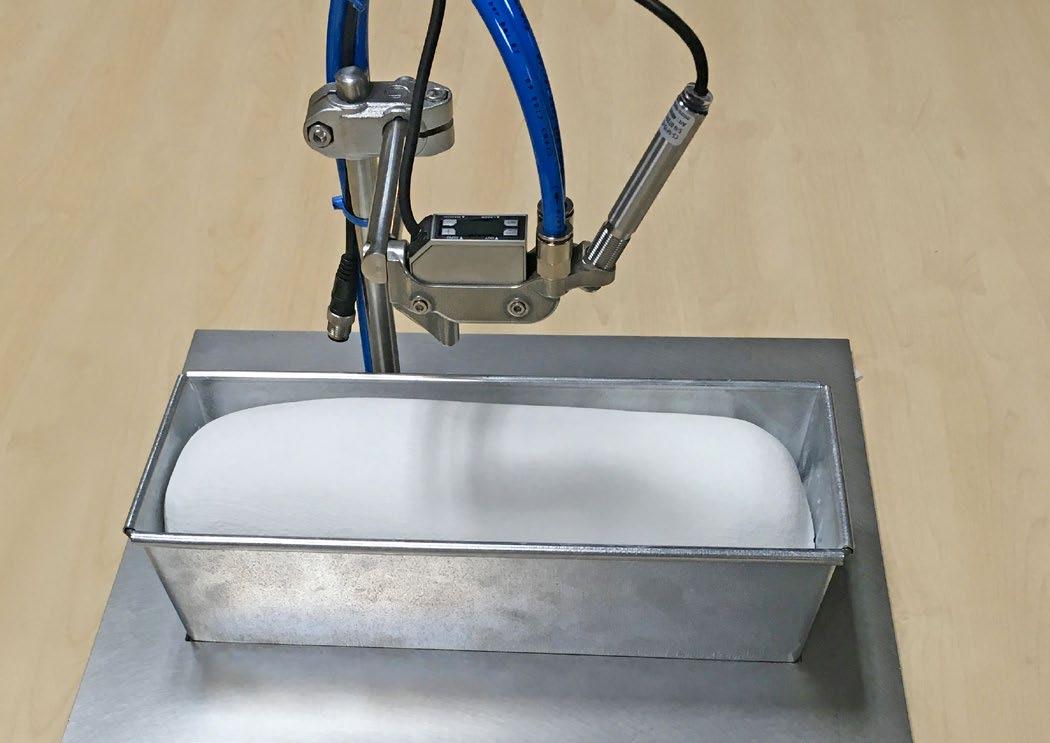
process. The sensor could be placed anywhere in process where the dough can stop moving for a couple of seconds. At different locations in the process, it could help identify different changes, like if there was a change in the dough due to ingredients, recipe or due to the mixing process.
Currently, the technology is being validated and will need more work to validate various recipe and environmental changes, and on various types of dough. This includes more research to see how gluten free doughs would behave with this technology. There are some challenges that could also affect the data gathered including, for example, if the dough was not placed in the middle of the tin, if the dough was folded, or if in a strange shape.
This technology is not ready for market as it is still in the early stages of development, and needs more research to ensure effectiveness across various recipe changes and dough types. In the future, this technology could be a valuable tool for a baker to ensure they are producing a consistent, quality product every batch, every day. +++

www.bakingbiscuit.com 06/2018 IBA 18
© Kaak


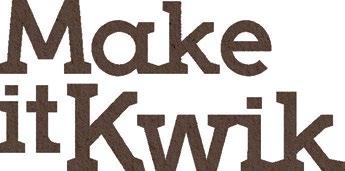

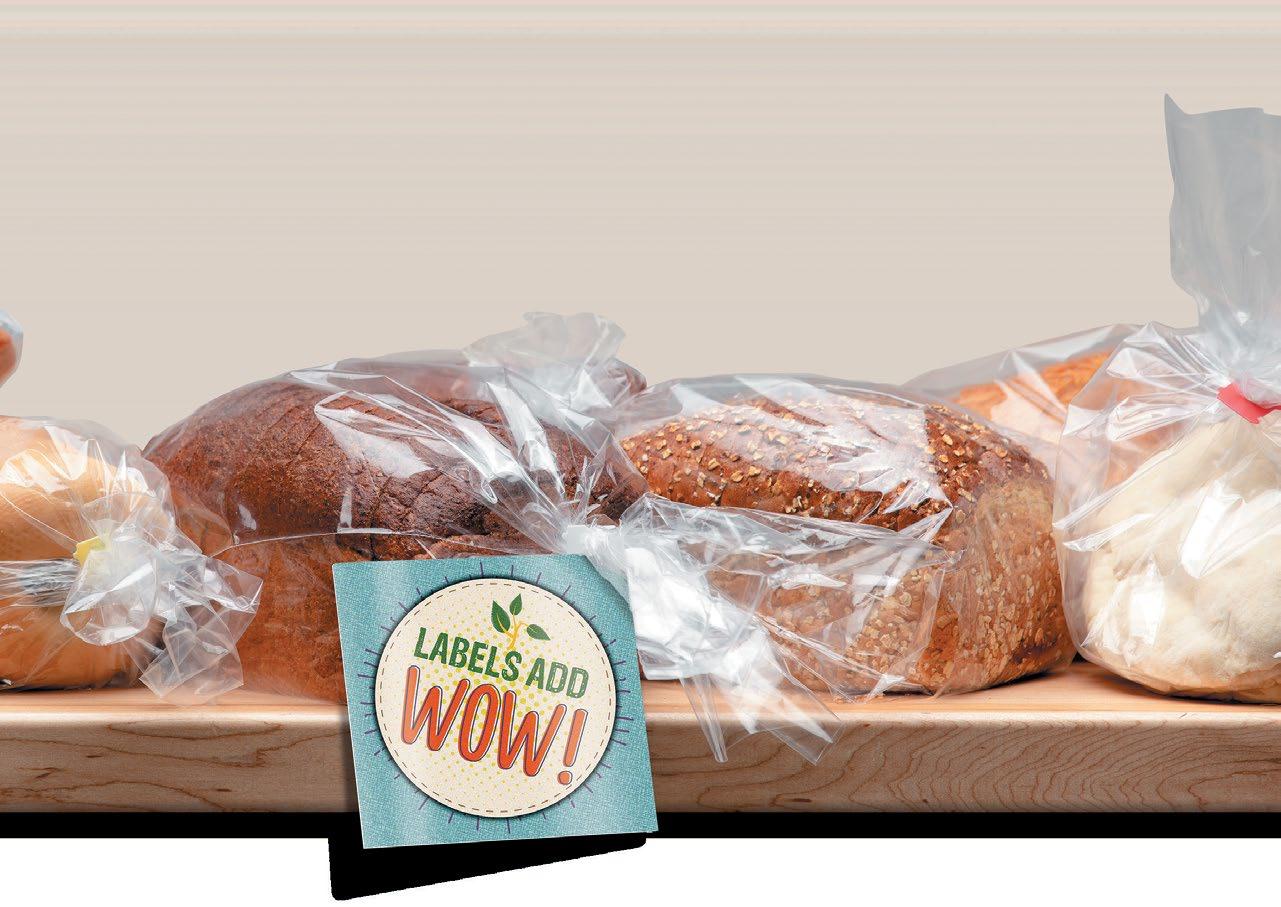
A new instore baking process
The equipment was so small that the description “inconspicuous” really isn’t an insult. Nonetheless, the “UDO” made by Cetravac AG in Switzerland was awarded a trophy at the iba trade fair, and attracted a large amount of attention. We asked its inventor, Adolf Cermak , what really lies behind it.
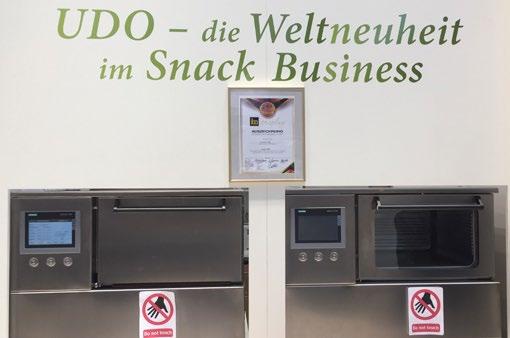
+bbi: A small equipment built into a wall – precisely what have you actually presented to the world that has caused such a stir?
+ Cermak: Don’t jump to conclusions about its importance from its size. What we mainly wanted to do by exhibiting the Snack Oven in Munich was to demonstrate that of course the principle also functions on different scales, and may even revolutionize instore baking.

+ bbi: Then please start by just explaining that principle to us ...
+ Cermak: I will explain it to you by using a frozen par-baked pizza as an example. First of all, the frozen product is put into the oven, which has previously been brought to operating temperature (approx. 160°C), and a vacuum is created in about 15 – 20 seconds. This sucks the air out of all the product’s pores and clears the way for the steam which then flows in. The steam heats the crumb and crust stepwise to at least 80 – 85°C. Since heat transfer from the steam to the crumb/ crust structure takes place with otherwise unattainably high efficiency, the duration of this process lasts only a few seconds and, in contrast to the use of microwaves, is associated with an improvement in crumb quality and an increase in crumb moisture. The as yet un-gelatinised starch gelatinises, which heightens the impression of freshness. At the same time as the steaming, infrared radiation elements heat the product’s coating/surface with a wavelength specifically matched to the process. At the end of the baking process, a short (approx. 15 – 20 seconds) vacuum cooling phase is started (in the oven, which is still hot), and the ready-to-eat product can be removed at a palatable temperature.
+ bbi: So how long does the entire process now take, from loading the pizza into the oven until it is removed, and what are the specific benefits compared to other processes?
+ Cermak: It takes about 60 to 90 seconds. The time it takes to prepare a coffee is sufficient to optimally bake a pizza and cool it down again. The process is considerably faster when compared to a circulating air oven, and in contrast to the microwaves that are often used, there is no adverse effect on the dough structure. Also, there are none of the “sideeffects” caused by unequal heat uptake in a microwave, which can result in the consumer biting into an extremely hot piece of tomato that was covered up by a distinctly cooler slice of cheese.
+ bbi: But the oven is small nonetheless. Not much more than a pizza would fit into it. Will there also be bigger ovens in the future?
+ Cermak: This Snack UDO is only a forerunner for a whole series of vacuum baking ovens that Cetravac will launch onto the market in the near future. The spectrum ranges from a domestic appliance to instore ovens in all the usual sizes. The instore ovens will differ from the Snack series in that they will operate with circulating air, thus also enabling conventional baking followed by a vacuum cooling phase. However, the main application in a bakery branch is aimed at the ultrafast baking-off of pre-baked special and large breads in only four to eight minutes, even for breads weighing 750 – 1,000 grams that were stored at “ambient” temperature or frozen. This will enable artisan bakers to recapture
www.bakingbiscuit.com 06/2018 IBA 20
© LANDMAGD ©
cetravac
++ Udo – the global novelty in the snack business
the bread business. One advantage of our method is that there is no weight loss in spite of the cooling phase that is included in the entire process.


+ bbi: In the planned instore oven, is there also a function for vacuum, steam and infrared, or just circulating air baking as in the past, and faster cooling down by vacuum –or to put it another way: can I also bake bread rolls and croissants quicker in it?









+ Cermak: It’s similar – the infrared elements are replaced by circulating air, but the whole of the baking process continues to be “vacuum-assisted”, i.e. there again the absence of air in the pores is used to accelerate the baking process and to bring about gelatinisation/re-gelatinisation of the starch, thus leading to considerably longer shelf life and freshness retention. There can always be a vacuum cooling phase at the end, whatever is being baked, and that’s a unique selling point which represents an absolute guarantee of success for the Internet trade, where it’s a question of being able to dispatch freshly baked bread as quickly as possible. And of course, the benefits of increasing and stabilising volume can also be fully utilised in that situation, at all times and for every product.
+ bbi:





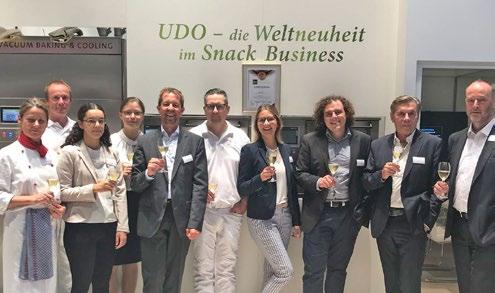
So what was the feedback at the





iba trade fair?
+ Cermak: Very positive and very wide, as far as the spectrum of potential customers was concerned. Of course, many bakery specialists from all over the world were there, as well as people from the trade and food service, who were interested in this oven because it allows such a fast response to consumers’ wishes. But equipment supplier also showed great interest, including those from the USA, because it opens up a completely new worldwide market.
+ bbi: So what will you do now?
+ Cermak: We have an absolutely unique world market position with this equipment design concept. In the coming weeks and months, together with a small but very potent group of future users from the two key areas, snacks and baked products, we will define a series of machines corresponding to the needs in the years to come, and these machines will be on the market in 2019.
+ bbi: Thank you for the interview, Mr. Cermak. +++

www.bakingbiscuit.com 06/2018 IBA ADVERTISEMENT
©
cetravac
Parallel to el to BUY ADMISSION TICKETS ONLINE NOW AND SAVE UP TO 45%! Koelnmesse GmbH Messeplatz 1 50679 Köln, Germany Tel. +49 1806 383 763 Fax +49 221 821-991360 visitor@prosweets-cologne.de www.prosweets-cologne.com The international supplier fair for the sweets and snacks industry 27.01.–30.01.2019 PRODUCTION AND PACKAGING TECHNOLOGY PACKAGING AND PACKAGING MATERIALS RAW MATERIALS AND INGREDIENTS OPERATING EQUIPMENT AND AUXILIARY DEVICES PSC 2019 Anzeige Baking Biscuit intl 90x265mm Intl GB indd 1 PSC_2019_Anzeige_Baking_Biscuit_intl_90x265mm_Intl_GB.indd 1 01 10 18 07:5 01.10.18
++ The Cetravac crew after the award of the iba trophy
Dividing and moulding competence
The Werner & Pfleiderer (W&P) TEWIMAT is designed for industrial 24-hour operation and is available in two high-performance variants: TEWIMAT SOFT and TEWIMAT BIG BALL.
+The TEWIMAT SOFT and TEWIMAT BIG BALL have been designed to perfectly process long maturing, soft dough as well as larger weights. The equipment can be combined and can be further expanded according to the area of application with the TW PLUS remoulding station.
As the centerpiece of industrial processing lines for bread rolls, breads, pizza, tortilla, flat bread and many other products, the TEWIMAT’s high quality in dividing and moulding and its absolute weight accuracy for up to 30,000 dough pieces per hour are very convincing. The new TEWIMAT SOFT variant was given a unique mechanical design so that it processes dough that has pre-proofed for a longer time with a yield over 170 particularly soft and gentle. In conjunction with the BIG BALL equipment, the weight range can thus be expanded to 100 g to 600 g.

The additional remoulding station, the TW PLUS, achieves optimal round-moulding results of the dough pieces in higher weight ranges. Ideally suited also for further processing into products, such as pizza. Thanks to the double moulding time and the twice as long moulding path, the process of additional remoulding provides the opportunity to optimize pressure and speed to ensure that the dough structure is retained. Industrially produced dough can thus be prepared with artisan quality.
Dough divider
The TEWIMAT dough divider and moulding machine can be integrated in all semi- or fully-automatic systems. The machine can be used in a wide weight range from 30 g to 600 g and is available with 2 to 10 lines. Depending on dough quality and dough weight, an hourly output of 2,000 to 3,000 pieces per line can be achieved.
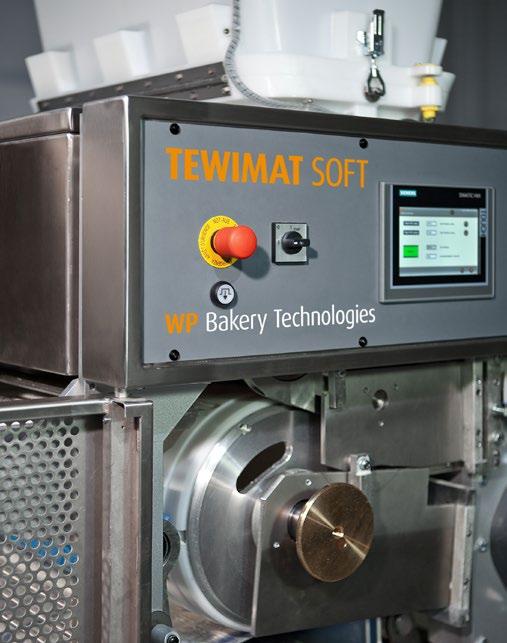
The suction divider technology that uses no feed rollers and dividing knives and the drum moulding system render the TEWIMAT particularly gentle on the dough. A range of interchangeable chamber drums is available for the different weight ranges to achieve best round-moulding results. Output, working intensity and weight can also be individually programmed to suit the respective dough requirements.
The dividing process which is oil-free for most dough avoids effects on the dough structures and minimizes operating costs. Maximum dividing precision can still be guaranteed at a low filling pressure, the basic prerequisite for a dough-friendly work method, since the patented de-gassing system allows air pockets to escape during the dividing process.
The TEWIMAT is easy to clean thoroughly. To avoid soiling from the outset, the drive-controlled part is physically separated from the part that handles the dough. This prevents the dough from falling onto drive components, such as gears. The dough-handling part of the TEWIMAT can also be fully disassembled as well as removed and reinstalled largely without tools. Because it is so easy to access, the TEWIMAT is also very maintenance-friendly.
++ Because it is so easy to access, the TEWIMAT is also very maintenance-friendly
www.bakingbiscuit.com 06/2018 IBA 22
+++ ©
© W&P
W&P
++ TEWIMAT is designed for industrial 24-hour operation
Introducing Hydrobond from Exact Mixing




















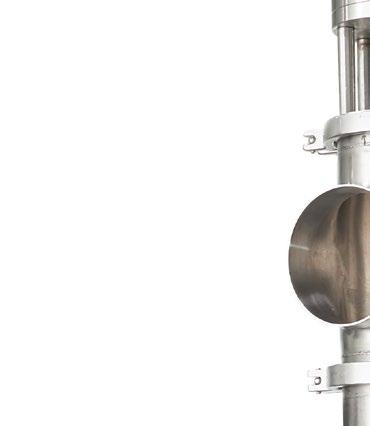


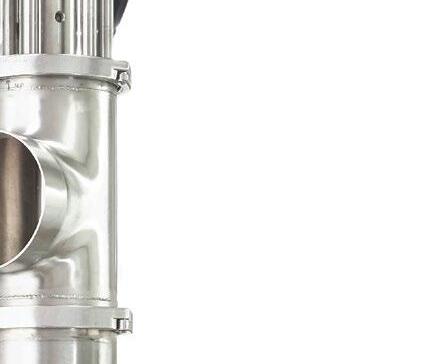



Want superior hydration without adding excess heat to your dough? New Hydrobond technology delivers. Not only does it blend dry and wet ingredients with unmatched efficiency, it also:

• Requires no additional floor space




• Reduces your total mixing time
• Cleans quickly and easily






• Reduces heat attributed to mixing energy



• Allows you to mix more dough with same size continuous mixer







 BY READING BAKERY SYSTEMS
BY READING BAKERY SYSTEMS




Perfect your mixing process with new Hydrobond technology. Visit exactmixing.com for details.
Advanced hydration technology is here.
A Markel Food Group Company EXACT
MIXING
The optimal complement to our line technology

Digitalization is a megatrend that is affecting all industries and services. Used wisely, digitalization can make even the production of baked goods easier and safer. FRITSCH, as a leading manufacturer of bakery machines, already picked up on this trend as it was just starting to appear. Concretely, we got into strategic discussions with our customers, drew on the know-how of our experts, and investigated case examples from other industries for best practices. For us, digitalization is not an end in itself, rather a tool to be fine-tuned specifically to the needs of our customers who work with semi or fully automatic FRITSCH machines. Our goals are clearly defined: smart services should represent a further improvement in our services and should offer our artisanal and industrial customers a tangible benefit. It will help our customers meet the chal lenges they are facing, such as the industry-wide lack of skilled workers, minimization of downtimes, and the consumer demand for high, consistent product quality. We have identified many beneficial services by which we can provide a boost in our customers’ workflows. The first three Smart Services provided by FRITSCH, which increase plant availability by constant component monitoring, allow real-time efficiency ana lyses, and improve customer support in the context of repair and maintenance, were presented at iba 2018.
THE TECHNICAL ARCHITECTURE – KEEP IT AS SIMPLE, SAFE AND FLEXIBLE AS POSSIBLE


Our Smart Services are based on additional hardware that can be optionally built into our lines. Strategically placed sensors capture and aggregate data, which are first stored in the line‘s buffer memory. So they can be used for our services, the data are then sent for analysis to the FRITSCH Central Server, which meets the highest demands in security. Open interfaces allow for future integration of customer-specific MES and ERP systems. Overall, this technical architecture offers maximum flexibility for our customers.
The second service, the Data Cockpit, is a means of real-time calculation and visualization of efficiency indicators. Depending on the customer’s needs, custom reports can be prepared as an important tool for controlling and optimizing production.
With Remote Maintenance Support, FRITSCH assists its customers in routine maintenance and troubleshooting with the help of data glasses. These glasses provide an easy means


www.bakingbiscuit.com 06/2018 IBA 24
Services
Smart
can be purchased in the FRITSCH Store
IO-LINK MASTER SIEMENS SPS LENZE SPS DATA COCKPIT DATA CONNECTOR CUSTOMER LINE (e.g. IMPRESSA bread) optional MES SYSTEM SMART SERVICES PLATFORM FRITSCH CENTRAL SERVER Raw data from the lines SMART CONDITION MONITORING DATA POINTS Safe SSL exchange FIREWALL FRITSCH STORE Smart Sensors Motor temperature Cabinet monitoring Fuse monitoring Machine data Process data Control data Converter data Motor data Product data Error messages
Further scheduled services as from 2019
© FRITSCH © FRITSCH
of communication between the customer and his appointed FRITSCH service expert. Backed by this support, using mixedreality applications and bidirectional video transmission


ADVERTISEMENT
MIXING SOLUTIONS
for bread, pastries, cakes and snacking industries

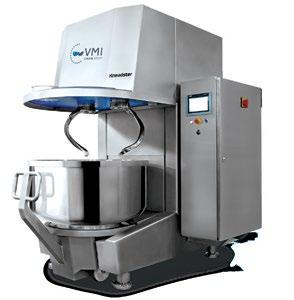

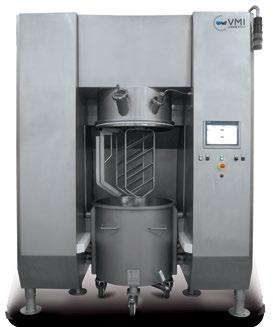
with voice communication, customers can diagnose problems very fast and thereby promptly eliminate complex faults to restore regular operations in short time. +++

25 IBA
© FRITSCH © FRITSCH © FRITSCH
31 Oct - 2 Nov 2017 Duba World Trade Centre
Optimizing roll production
Kövy Bäckereimaschinenbau GmbH, Dortmund, presented an automatic peelboard stacker at the iba trade fair. The plant allows bread roll production to be optimized.
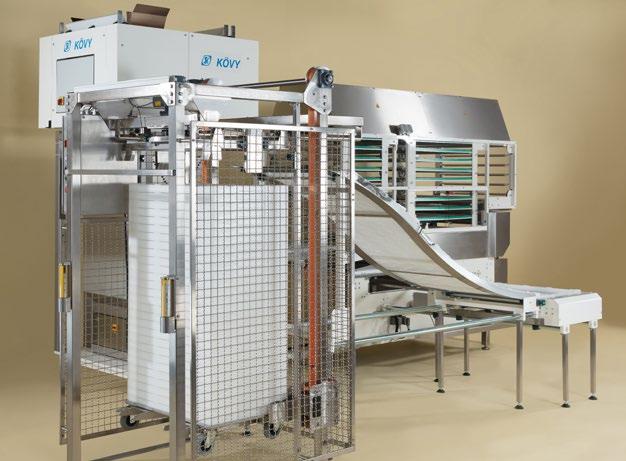
+Kövy Bäckereimaschinenbau GmbH, Dortmund, presented the automatic peelboard stacker, already patented in 2016, to a wide audience at the Munich trade fair. The plant allows various machine types to be supplied with peelboards fully automatically. The reason for developing
this plant arose from the problem that proofing carriers/ peelboards are often fed into bread roll plants by hand. This operation subjects the employee involved to constant physical stress. Equally, the roll machine often needs to be halted, leading to a reduction in hourly performance. The fully automatic peelboard feed system can now help bakery businesses optimize their roll production.
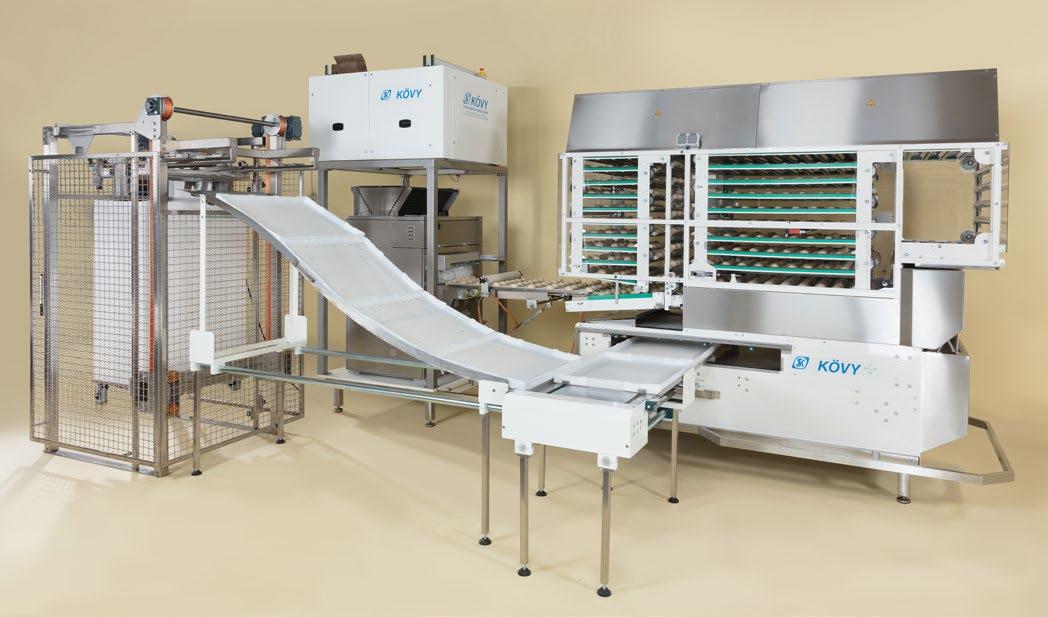
Mode of operation
Empty proofing carriers/peelboards are stacked on undertrolleys up to the cooling door’s headroom height. An employee drives these stacks into the infeed device, where a kind of peelboard lift elevates them fully automatically to the height of the subsequent chute leading to the bread roll line. This allows the employee to remove the loaded proofing carriers/ peelboards, and the roll machine can run without interruption. Tilting bread roll peelboards measuring 59 x 39 cm and 77 x 57 cm can be used. If needed, the peelboard stacker can feed two parallel bread roll lines. The peelboard stacker is also designed for ease of operation. Kövy also supplies a matching trolley for onward transport of the proofing carriers. On the one hand, the stacker relieves the burden on the production unit’s staff, and on the other the space in the bakery can be used in an optimum way. The stacker is 300 cm long, 120 cm wide and 250 cm high. The plant holds 2 x 33 peelboards (60 x 40) or 33 euroboards. +++
www.bakingbiscuit.com 06/2018 IBA 26
© Kövy
© Kövy
++ The peelboard stacker is on the left. Proofing carriers enter the bread roll plant through a chute
++ The bakery machine constructor Kövy presented an automatic peelboard stacker designed to supply proofing carriers to bread roll plants
-Dough Make-Up
-Proofing
-Seeders, Toppers, Pan Shakers & Water Splitters
-Depositing, Portioning, Filling and Pumping
-Ovens (Tunnel, Conveyorized, Serpentine, Tray, Rack and Deck)

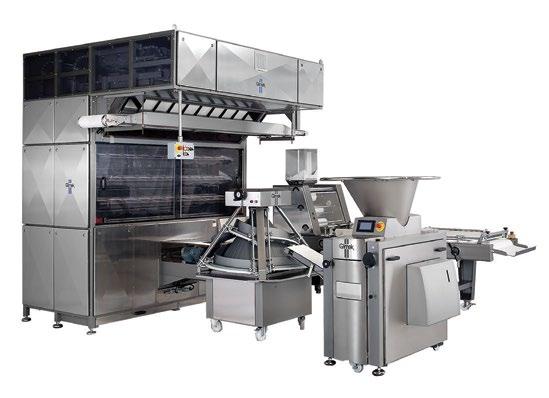
-Cooling
-Pan & Product Handling Systems
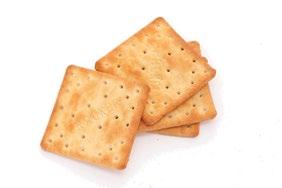




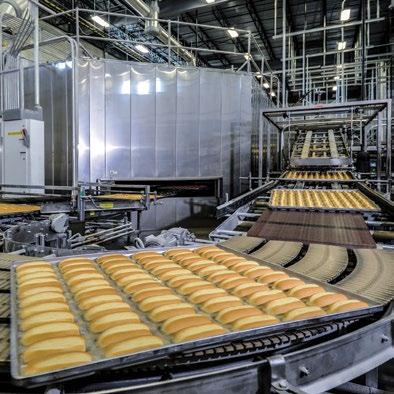

-Packaging & Distribution

info@middlebybakerygroup.com www.middlebybakerygroup.com +1 469 464 5411
Complete Industrial Bakery Production Lines
Our promise: we will improve your overall user experience, guaranteeing you the lowest cost of ownership.
Slicing technology at the iba
+“Do not disturb!” – tersely worded, admittedly, but it puts in a nutshell the demands placed on slicing machines, especially when used in branches: they must be coordinated with the shop-fittings or in a trendy black housing, occupy little space, do their job reliably, hygienically, safely and quickly, and require little maintenance.
JAC showed the SLIM version of its black-fronted circular knife cutting machine. Loaves to be sliced are fed into this machine standing on end. Slicing vertically instead of horizontally has one decisive advantage: the construction is narrow, as the name suggests, so it occupies little floor space, and 60 x 60 cm 2 is enough to handle loaves 42 cm long, 25 cm wide and 16 or 20 cm high. The user selects a slice thickness between 5 and 25 mm via a touchscreen. Crumbs drop into a crumb drawer accessible from the front. Also shown was the new Swift type of cutting machine whose simplified feed system can speed up slicing. The machine cuts brown bread, toast-bread and even warm bread at the rate of up to 360 baked items/hour.
Packaging
A GHD Hartmann seal-&-fold machine creates a fanshaped ruffle on bread bags. The machine can be positioned downstream of slicing and packing, and seals the bag, shapes the fan and fixes the ruffle with a clip. The main demand for this type of packaging is in the Asian region, which is not surprising bearing in mind that it corresponds to the Japanese ideal of beauty.
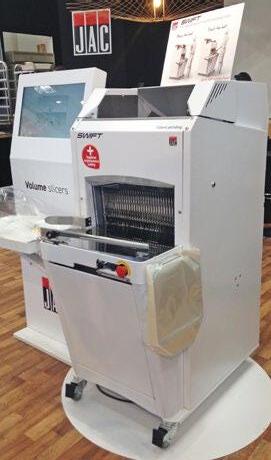
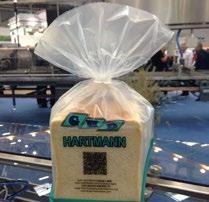
Weber Packaging has a practical idea to pack topped snacks in the out-of-house market – to meet the needs of both packing and unpacking. The snack is packed by putting it into the “Snack Bag”, rolling it up, and it’s ready.

“Integrable” was Treif’s keyword. The company showed its Primus fusion for the first time; a bread slicer than can be entirely built into the shop-fittings. The machine can be positioned under the sales counter or, ergonomically better, slightly higher in a rear or side wall. It cuts bread varieties up to 360 mm long. The bread is guided by a gripper hook and a slice-holder, which the manufacturer says ensures accurately cut slices from beginning to end.
Black, anthracite, stainless steel, white or wood decor – MHS Schneidetechnik presented its “MHS Premium Touch” circular knife machine with freely selectable, interchangeable facias that turn the slicer into a design feature. The manufacturer says the machine can even slice warm breads, and achieves an output rate up to 220 slices/minute.
Rego Herlitzius Rotec 350-526 circular knife machines operate with an epoxide-free BAL2017 BIOSHIELD knife coating. The company says this new generation non-stick coating offers the best possible anti-bacterial protection due to its special growth-inhibiting properties. Other advantages are said to include great abrasive wear resistance, a powerful non-stick effect and long service lifetimes through optimum slip properties. The Rotec 2000 semi-automatic V2A circular knife machine is designed for cutting capacities up to 300 slices/minute, equivalent to around 21 loaves/minute depending on slice thickness.
Since March 2018, Rego Herlitzius’ industrial business has been in the hands of MKW GmbH, which markets these bakery machines under the Herlitzius brand. The company supplied information at the iba trade fair about the Rotec 3000 automatic bread slicer with a fully automatic loaf feed
++ For out-of-house consumption: the Thermo Bag is said to keep warm snacks hot for the same length of time as aluminum foil
A self-adhesive closure is used for fastening. The consumer opens the pack using a tear-open perforation in the middle, so one package half remains around the product and acts as a crumb-catcher and spill protection. The package is available in a paper look with greaseproof paper, or combined with a PET see-through window. The “Thermo Bag” variant consists of two layers of greaseproof paper (with or without a PET see-through window), and is said to keep warm snacks hot for just as long as aluminum foil.
IBA 28
+++ www.bakingbiscuit.com 06/2018
© JAC
++ The Swift can slice up to 360 breads per hour
++ For sliced bread: the bag with a fan ruffle
© Weber Packaging
© f2m
system, circular knife oiling depending on the type of bread, rotation speed independent cutting speed for optimized slicing with different bread types, and remote maintenance via Ethernet.


GHD Hartmann showed the KM 600 P slicer, designed for capacities of up to 600 cuts per minute. It slices and portions baguette bread to an accurate weight. Before cutting, the breads are weighed and their density determined. Each baguette’s density profile is sent to the controller, and the baguettes are cut accordingly to maintain a 500-g portion weight, for example.
Ultrasonic cutting
We set our focus on your product!
The ultrasonic cutting machine specialist Döinghaus presented the “Ultracut Filou” model equipped with new software. According to the company, it cuts and slices cakes and confectionery products highly accurately and without loss. Eleven different cut variants are now possible, including rectangles, triangles, gateaux and a diamond slice.
Bakon’s InlineSlicer Ultrasonic ultrasound cutting machine slices rectangular (up to 600 x 800 mm) and round cakes (up to 380 mm diameter). With almond slices, for example, the ultrasonic cutting machine travels through the surface more slowly so as not to break it up, while the soft part of the baked item is cut through faster. The cutting pattern is also variable and, like the number of pieces, cutting speed, edge width etc., is programed on a liquid crystal display screen. An unloader that lifts tray cakes from the baking tray and deposits them onto the infeed belt is also offered as an accessory. +++

ARTISAN SFM EC
THE DOUGH SHEETING LINE FOR LARGEAND FINE-PORE DOUGHS IN EASY CLEAN DESIGN

Koenig’s new dough sheeting line provides a performance of 33 strokes / min. for artisanal bakeries with a new system of dough sheet production. The line is suitable for fine-pore doughs as well as for large-pore doughs with a high water content, thus enabling a high variety of buns from wholegrain buns to Mediterranean ciabatta. For easy cleaning, maintenance and access to all modules, Koenig has applied the “Easy Clean” Design.
Awarded with the IBA Trophy 2018.
Follow us on our digital channels.

IBA ADVERTISEMENT
© MKW
++ Rotec 3000 automatic bread slicer
++ Döinghaus managing directors Dieter Döinghaus (l.) and Holger Witkowski in front of the Ultracut Filou
Koenig Maschinen GmbH | A-8045 Graz | AUSTRIA info@koenig-rex.com, www.koenig-rex.com
© Döinghaus
Durable coating
Kempf GmbH, Rohrbach, specializes in the “Bakeware & Coatings” areas. At the iba trade fair, the company presented the new 704 fluoropolymer coating for trays and pan clusters.

+Kempf GmbH in Rohrbach is a medium-sized family business that has specialized in the “Bakeware & Coatings” areas for around 50 years. Thanks to qualified staff and modern fabrication lines, the company promises to offer the very highest quality at fair market prices. The company’s standard range includes baking trays and perforated metal trays, plant trays, pan clusters, rack and freezer trolleys, slice trays, counter trays and snack wells. The company also offers non-stick coatings specially matched to the customer and/or product.
Kempf GmbH is also partnered with Teflon™ Industrial Bakery Solutions, which gives it access to the Chemours company’s expertise.




Fluoropolymer coating


The company now presented the new KG-Flon 704 fluoropolymer coating at the iba trade fair. This coating can be applied to baking trays, pans, plant trays and baguette trays, for example, and also to pizza trays. In addition to good non-stick properties and good abrasive wear resistance, the company promises up to 10,000 baking cycles without needing recoating. KG-Flon 704 was developed specifically
for industrial bakery use. The company adds that due to this coating’s unique properties, it is very often used on tinned bread lines, automatic baguette lines and bread roll lines, and also on special trays. The fluoropolymer coating’s temperature resistance ranges from 30°C up to +270°C. The company also presented its new peelboards, which are very lightweight and suitable for a variety of automatic lines. +++
IBA 30
++ In collaboration with the Chemours company, Kempf GmbH can offer a variety of coatings
Gin bakery in London • Read the whole story on • backweltblog.com ADVERTISEMENT
++ As well as pan clusters, the company also coats various trays, and also fulfills individual customer’s requirements
Rise above the competition with GEA Bakery Equipment
With 100 years of combined experience, GEA Comas and GEA Imaforni have been engineering high quality solutions for the baking industry. With that kind of history behind us, we have gained world-leading knowledge and expertise to offer you complete production solutions, from dough making to packaging and everything in between, customised to suit the precise requirements of your line of products.
Our range of baking equipment ensures you maximum productivity whilst maintaining the best product quality. With fully automated plants able to run non-stop, we reduce the need for human interaction, thereby reducing the risk of human error and product contamination.
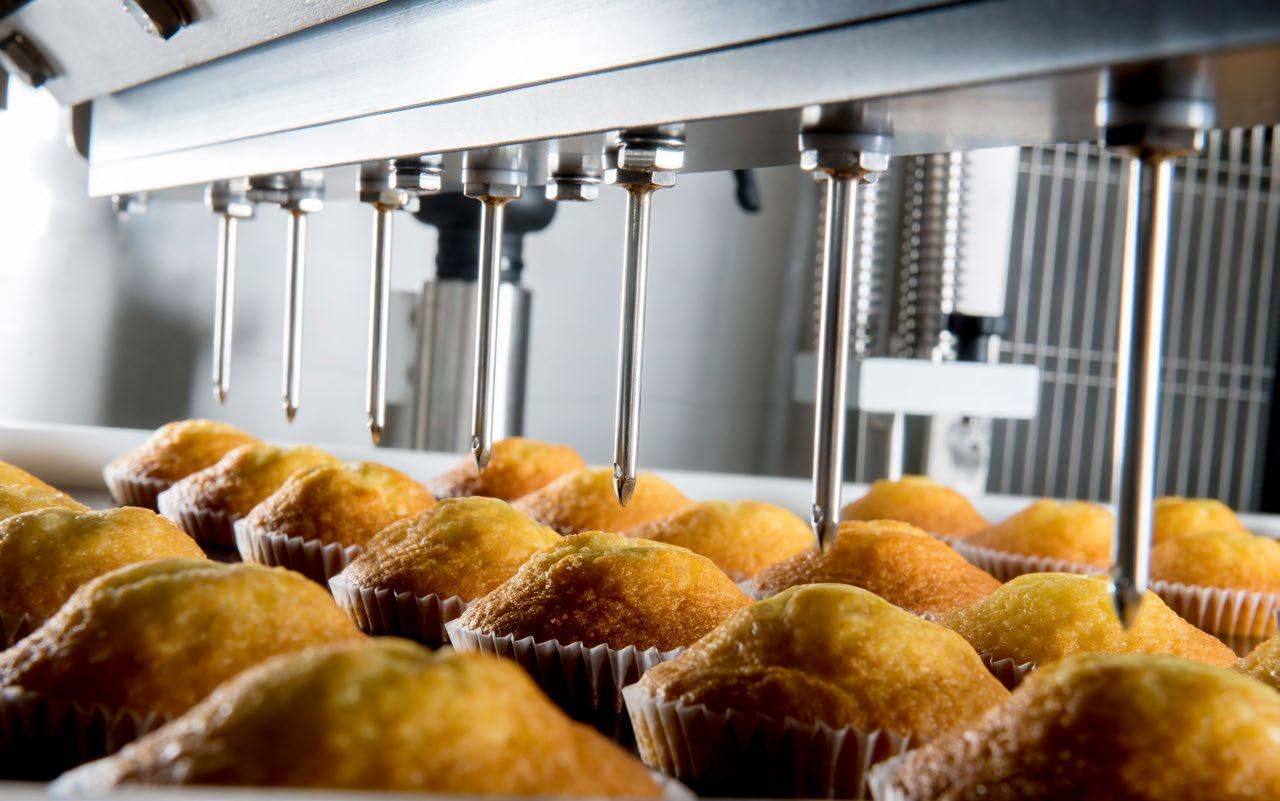
You can also take full advantage of our new Bakery Experience Centre where you’ll be able to test your own products on our equipment, and utilise the knowledge of our specialist food technician to help refine your recipes or make a new product. Experience for yourself the winning combination of our equipment and expertise. After all, the proof is in the pudding. Enquire now at gea.com/bakery
We look forward to meeting you at iba 2018 Hall A6 – booth 211 in Munich, Germany from 15 – 20 September 2018.

Cooperation between FEDIMA and FIPU

FEDIMA – The Federation of European Manufacturers and Suppliers of Ingredients to the Bakery, Confectionery and Patisserie Industries – are national associations across 13 EU member states. FEDIMA represents estimated 200 companies with approx. 5 billion EUR turnover.

FIPU – Food Ingredients Producers Union has been around for more than 15 years uniting more than 60 companies engaged in production, research, sale and use of food ingredients for use in various branches of the food industry in the Russian Federation and the Eurasian Economic Union (Belarus, Kazakhstan, Armenia and Kyrgyzstan).

The bakery ingredients suppliers grouped at the European level signed a cooperation agreement with their Russian counterparts: The Federation of European Union Manufacturers and Suppliers of Ingredients to the Bakery, Confectionery, And Patisserie Industries (FEDIMA) and Food Ingredients Producers Union (FIPU) agreed to the exchange of information and experience on topics relevant to the respective member countries and member companies. The aim of the cooperation is to achieve continuous improvement for all stakeholders in various specialist areas. Particularly it will focus on an exchange of regulatory and legislative updates; on product denominations, food safety and handling of ingredients. The agreement has been signed in the margin of FEDIMA’s annual event which took place in Athens.
During her speech, FIPU President Tatiana Savenkova introduced the Food Ingredients Producers Union, which was found more than 15 years ago and unites more than 60 companies engaged in production, research, sale and use of food
ingredients. “We hope the Agreement between our associations, aimed at information and experience exchange on main issues and aspects of cooperation will contribute to harmonization of the requirements of the European Union and the Russian Federation legislation in the field of safety and regulation on the use of food ingredients, risk assessment and their circulation on the market; networking between producers and consumers of ingredients for bakery and confectionery production; improvement of information environment in the media with respect to the use of ingredients in food products”, noted Savenkova.
Johan Sanders, the President of FEDIMA highlighted the aspect of growing globalization and with that the rising need to be more interconnected. He sees this as “an important opportunity for both, our members, as well as for our Russian counterparts.” He added: “we should not stop here. We hope to expand our cooperation with our American colleagues.”
www.bakingbiscuit.com 06/2018 NEWS ++ NEWS ++ NEWS 32
+++
© FEDIMA
++ Johan Sanders (Fedima President) and Tatiana Savenkova (FIPU President) signing the memorandum
© FEDIMA
ls1MPLER
At MECATHERM, our mission is to da everything to simplify our clients' life and provide leading industrial solutions adapted to their needs, everywhere in the world. Because our clients' satisfaction and loyalty is our source of business.

WWW. MECATHERM.FR


simpler MECATHERM
Hake your industrial bakery
Fully automatic – but with a touch of craftsmanship
Pizza production is one of the key points of expertise of Kaak’s Italian MCS subsidiary from the northern Italian commune of Ala. The Italians’ latest highlight is a new, fully automatic pizza press.

Pizza crusts can be made in two ways. They are either cut out of the dough sheet, or a ball of dough is pressed into a round disk. The latter is considered the more sophisticated process because it at least comes close to a pizza chef’s manual production method. Due to the round molding of the dough ball and the period of rest that may have preceded it, this process also achieves a classic pizza dough structure and the edges are closed, as with a hand-formed dough crust.
Nevertheless, different procedures also exist for stamping out pizza crusts. One can, for example, let the stamp act on the dough hot or cold. The dough can be pressed into a mold, or on a belt. The new pizza press from Kaak’s MCS subsidiary can do all of that, hot and cold, and either in a mold or on a belt.
The press tool can be adapted to every requirement according to product size, profile and thickness, as well as to press

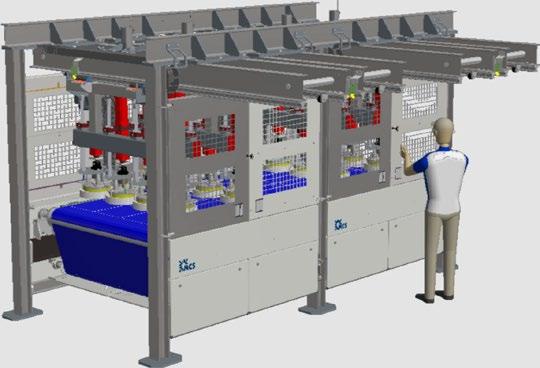
www.bakingbiscuit.com 06/2018 PRODUCTION 34
+
1 2
© moloko88 –123rf.com © karandaev –123rf.com
MCS, Ala/Trentino
parameters such as speed, force, time and temperature. Each individual press head is driven by servo motors, while each press punch can be coated for pressing with or without oil. In addition, the product’s top and bottom heat can be controlled just as precisely as all the other press functions. If the dough is to be shaped especially gently, one can also press sequentially, i.e. in several small pressure sequences, until
the dough has attained its final shape and size. Ala’s engineers have paid great attention to the system’s hygienic performance. The press can be pulled out to the side so that changes in format, as well as cleaning and maintenance, can be made easily and quickly. The entire construction is of stainless steel. It is robust, hygienic and available in a wash-down version. +++
The rack oven.
Saves even more energy.
And is ahead in most other aspects, too. Your next MIWE roll-in e + 3.0.

Unique: atmospheric baking. Makes you independent of climatic conditions
Flexible baking characteristics: MIWE delta-baking
Is stingy with energy

– from connected load to overall efficiency














































Bakes to perfection: core temperature sensor
Ergonomically brilliant: soft close door, remote display, large screen
++ The press can be pulled out sideways so that changes in format, as well as cleaning and maintenance, can be done easily and quickly
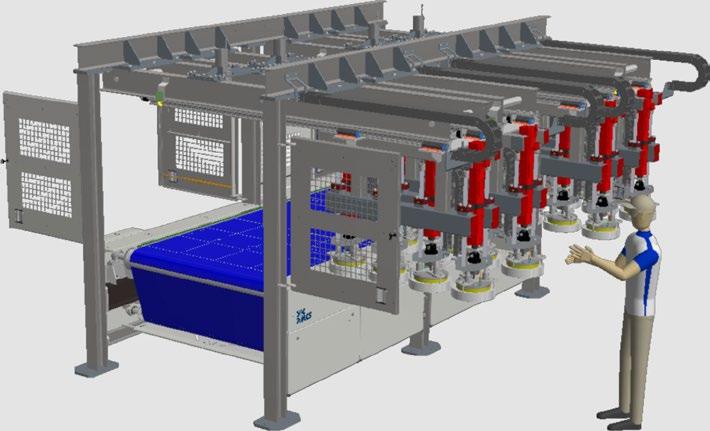
35 PRODUCTION ADVERTISEMENT
3 © MCS
Contact us: Phone +49 (0)9363 - 680 · contact@miwe.de · www.miwe.com/roll-in
“The award is great honor, but it is also an obligation. We scientists must stay in contact with the sector rather than remaining only in academic circles. My promise to you is that I will re-intensify the exchange.” These were Dr. Elisabeth Sciurba’s words when commenting on her nomination as the new Bread Senator of the German Industrial Bakeries Association. This distinction is bestowed by the German Industrial Bakeries Association on individuals in commerce, research and science who have rendered service to the bread production industry. According to the Association’s President, Prof. Dr. Ulrike Detmers, the new Senator fulfils these requirements

++ Obituary Adolf Fritsch

The FRITSCH Group, one of the leading German manufacturers of bakery machines and lines, mourns the passing of its senior partner Adolf Fritsch. The co-founder and long-standing managing partner of the family-run business in Markt Einersheim passed away in Prague on August 2, 2018, at the age of 89.
Adolf Fritsch was born in 1929 in Wiese, former Sudetenland, now the Czech Republic. After the Second World War, he and his family settled in the region of Kitzingen. There, his father Alois Fritsch continued the business he had started in 1926 in Sudetenland and, in 1948, established the FRITSCH company in Markt Einersheim. Even in his youth, Adolf Fritsch participated in his father’s business, helping him to build up the company. All the while, he completed his mechanical engineering studies in Würzburg and, starting from 1961, ran the company as the sole managing director.
Under his leadership, the company doubled in size. Adolf Fritsch succeeded in broadening the distribution network out to an international scale and in establishing long-
particularly highly. Prof. Detmers praised above all the scientific accomplishments of the new Bread Senator, who is currently working on projects that are important to the sector. Dr. Sciurba has headed the Food from Cereals work group at the Max Rubner Institute for Cereals Safety and Quality since July 2014. She is active in numerous specialist committees and advisory councils, including membership of the Technical Committee of the International Association for Cereal Science and Technology (ICC). +++
++ From cake-maker to bread-baker
The British Finsbury Food Group, which achieved sales revenues of GBP 314.3 million in 2017, was mainly a cake and cookie baker in the past. It ventured an entry into bread baking in 2016, and has produced white bread bloomers, tiger bread and sourdough breads since then. The line with a stone-plate baking oven installed at that time can deliver products for sales revenues of GBP five million, and according to Finance Director Steve Boyd it is working at full capacity. Finsbury supplies bread to the Waitrose, Co-op and Sainsbury’s retail groups, among others. That’s why Finsbury now plans to invest in more production capacities for “artisan style” bread. The Group bought Ultrapharm, a producer of gluten-free baked goods with production facilities in the UK and Poland, for an estimated GBP 25 million a few weeks ago. However, according to Boyd, Finsbury intends to further diversify not only its portfolio but also its distribution channels. He says six or seven years ago they worked exclusively for the retail, but now they already earn 22% of their sales revenues with food service companies. +++
lasting, stable customer relationships. He also considerably expanded the ROLLFIX range of machines with new innovative developments such as the TEILFIX dough divider for rye-based bread doughs. With this move, he set the course for the company’s current world market position. Adolf Fritsch pursued his entrepreneurial activities with heart and soul and was a man of extraordinary pragmatism. The outstanding reputation the company enjoys today arises, if nothing else, from the fact that Adolf Fritsch was always ready to pick up a wrench and help his customers, in person, on site. He always placed importance on good, trusting relationships with his employees and customers. In 1996, Adolf Fritsch handed the reins of the family business to the third generation, his son Klaus Fritsch, who continued to expand the company with success. Since 2016, Klaus’ children Anna-Maria, Elisa, and Jan have also been fellow partners of the company. Today, the company employs nearly 600 people and generates an annual turnover of approximately 100 million euros.
Aside from being an entrepreneur, Adolf Fritsch took an active role in the Municipal Council of Markt Einersheim and in the County Council of Kitzingen. For his service, Adolf Fritsch was awarded the Order of Merit of the Federal Republic of Germany in 2002. +++
www.bakingbiscuit.com 06/2018 NEWS ++ NEWS ++ NEWS 36
++ German Industrial Bakeries Association: Dr. Elisabeth Sciurba appointed as new Bread Senator
++ The new Bread Senator, Dr. Elisabeth Sciurba (l.) with Industrial Bakeries President Prof. Ulrike Detmers
© Verband Deutscher Großbäckereie © FRITSCH




contact@americanpan.com | americanpancom For more than 30 years, American Pan has led the way in baking tin and tray innovation; from energy-saving designs to industry-leading coatings. We don’t believe in “one size fits all.” By engineering trays, applying exclusive coatings and providing economic refurbishment programs to fit your exact product and facility needs, we help you save money, increase quality, and outpace the competition. Bundy Baking Solutions: American Pan | Chicago Metallic | DuraShield | Pan Glo | RTB | Shaffer SKELMERSDALE, UK | +44 (0) 1695 50500 IRLAM, UK | +44 (0) 161 504 0771 THE PERFECT PAN from the first bake to the last. Contact our sales team to get started on your custom pan or cleaning program today. BARCELONA, SPAIN | +34 93 781 46 00 ALEXANDRIA, ROMANIA | +40 247 306170
The logjam has broken


The proportion of online sales of Fast Moving Consumer Goods in the Netherlands was 4% of the household market and still straightforward. But the logjam there now seems to have broken.
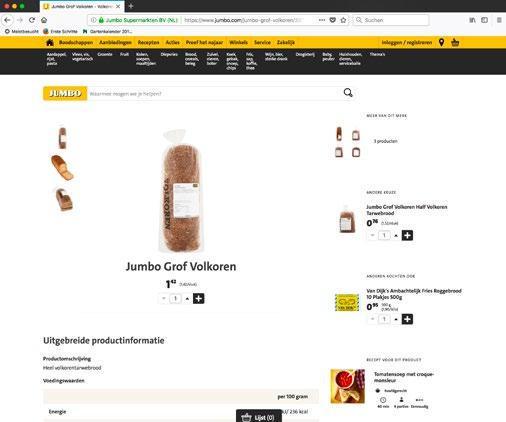
+T he growth rates for Fast Moving Consumer Goods (FMCG, literally: goods with a fast turnaround on the sales shelves; also called daily necessities a nd including food, drinks, detergents & cleaning products, t oilet paper and pet food) are on a steep upward track.
The number of households in the Netherlands who order their food and household articles by smartphone, laptop or stationary computer and have the goods delivered to the doorstep is increasing. According to GfK (the Consumer Research Association), the Food/Near-food category showed a 52% sales upturn in the fourth quarter of 2017, thus outpacing even a merchandise category like Media & Entertainment, which only grew by 21%. In all fairness, however, one must acknowledge that the starting point in the latter case was far higher than for food and household articles.
As GfK discovered, 95% of all Dutch consumers over the age of 15 bought goods or services online last year, for which they spent a total of EUR 22.5 billion, 13% more than in the previous year. They pressed the Buy button a total of 201.7 million times and used it to buy products 159.76 million times and services on 41.9 million occasions.
Be that as it may, the Food and Nearfood category still grew by +35% over the whole of 2017. Only Health & Beauty Products at 46% succeeded in adding even clearer growth.
According to Lenneke Schils, Industry Consultant at GfK NL (Consumer Research Association, Netherlands), total online sales in the Food/Nearfood merchandise group in 2017 added up to EUR 1.3 billion, and this is only retail sales, which does not include the equally booming online food service market. Sales are divided between specialists and

classical retail chains. Platforms such as Amazon have not played any role up to now. One third of the household market’s sales (excluding B2B) is through specialist mail-order companies, e.g. Nespresso, wine merchants or the cook-boxes supplier Hello Fresh.
Two thirds are accounted for by “full-range suppliers” like Albert Heijn or Jumbo, who also operate over-the-counter markets, or the newcomer Picnic, which limits itself to online business in a similar way to the British model Ocado, and does not operate its own shops in the country.
Measured against all the food and other daily necessities such as pet food, detergents etc. bought by Dutch households from the food retail and specialist suppliers throughout the


www.bakingbiscuit.com 06/2018 MARKET 38
++ A classic: coarse wholegrain bread, 800 g for EUR 1.42 each in the Jumbo supermarket’s online shop
© Elizabeth Crego –123rf.com
promises bread with no artificial bread improvers, instead of which he relies on time. The production process, starting at the beginning and ending with packing, is said to last nearly 24 hours. “What you eat is bread, nothing more and nothing less!”
whole year, the 4% online share in 2017 showed a clear growth trend. If consideration is limited purely to the supermarket product range, the proportion in the Netherlands is 3.2%, and here again the tendency is steeply upwards.
According to Lenneke Schils, only baked products finish with below-average results. The total share of these sold online currently adds up to 2%. The market researcher attributes this to the fact that up to now the nearest “oven-warm baker” is currently so close to most households that people prefer to drop in there to buy their necessities, rather than lugging them around.

However, the number of artisan bakeries is noticeably decreasing, even in the Netherlands, and proximity is a protection that could fade away, as the following example shows.
The fact that freshness and quality do not protect against consumers switching to online shopping is shown by the trend in the retail fruit & vegetables trade. Anyone who thinks consumers want to personally check the quality and freshness of tomatoes, gherkins, pears or mangos before putting those that have passed the test into their shopping basket is mistaken, as exemplified by the Dutch. Now that independent fruit and vegetable businesses have become rare in the Netherlands, purchases in this merchandise group are marching on to online providers, not merely to over-the-counter retail. The proportion of online sales in the fruit and vegetables product range is higher than in the entire range of foods.
Zeppelin Systems GmbH
Messenhäuser Straße 37-45
63322 Rödermark, Germany
Tel. +49 6074 691 - 0
foodtechnology@zeppelin.com
www.zeppelin-systems.com
PLANT DESIGN RUNNING IN OUR VEINS –YOUR FUTURE ON OUR MINDS
The architect of your visions
Plant engineering redesigned: We offer you the choice rather than ready-made kits – because we integrate processes, not just parts –for more efficiency, flexibility and security. Innovative plant designs from the plant architects. For a perfect dough all along the line.

39 MARKET www.bakingbiscuit.com 06/2018 ADVERTISEMENT
++ In the online shop, Albert Heijn
031401843_AD_baking_biscuit_issue-4_184x130mm_RZ.indd 1 19.10.18 09:06
The picnic principle
The online supermarket Picnic was founded in Amersfoort in 2015, and straightaway succeeded in establishing its delivery network in this city with a population of 155,000. So successfully that it was even compelled to create a waiting list for new customers. It has no over-the-counter shops. Customers can place orders up to 22:00 hrs., which will then be delivered the next day. Picnic pools the orders and in turn orders from wholesalers, who deliver to three big distribution centers in the country. From there the goods are sorted onto trolleys that go to local distribution points called hubs, where they go into vans. The hubs are only distribution points, not storage or warehouses. Deliveries take place in the afternoons and evenings using electrical trucks developed by the company itself, which also carry chiller and freezer containers. Instead of driving separately to each individual customer, an algorithm compiles the optimum delivery route for each truck. This is the reason why customers cannot specify the delivery time. Instead, Picnic names a 20-minute time window within which delivery will take place. The ordering app gives an indication of where the truck with the customer’s own delivery is currently located. The minimum order value is EUR 25, and there are no delivery charges.

According to Schils, households that include millennials and members of young families are especially strongly represented in online purchases of food and nearfood. Online sales among this group as a proportion of total purchases of food and nearfood articles has reached around 10%. For these consumers, online shopping is above all a way to reconcile daily family and professional life, instead of frittering time away with standard visits to supermarkets and specialist shops.
If the analysis is broadened to include all online product ranges, it becomes clear that online shopping is not a prerogative of a single age class, but is appreciated just as much by youngsters as by Best Agers and seniors. Anyway, 43% of the online shoppers identified by GfK could look back on more than 50 summers. Mid-level income groups (59%) and middle-ofthe-range educational achievements (44%) are represented more strongly than those at the bottom and top ends of the scale.
Mobile devices like laptops, tablets and smartphones are by far the most popular devices for online shopping, which leads to the conclusion that purchases are often carried out while on the move, at the workplace etc. The vast majority of payments use iDEAL, a Dutch online payment system that allows customers to pay by direct transfer from a bank account (similar to giropay).
But what has induced the Dutch to turn increasingly to online shopping? Of course, it was the comfort and convenience of being able to order 24/7 from home or from anywhere else. Of the consumers questioned, 35% also mentioned the large product range as an advantage, and for 31% it was the opportunity to compare products at leisure. Low prices
accounted for 30% of the reasons for online purchases, and almost as many, 29%, named time-saving as an argument. More than one in five (22%) also found it was nice to be able to look for specific products via the search function.
Among the negative aspects, only two arguments were conspicuous. 52% found that not being able to take hold of the products, or at least to see them with their own eyes was not good, and one in two objected to the shipping costs.
However, online services are specifically addressing these two negative aspects. Picnic, for example, has completely eliminated delivery charges. Complaints about the poor quality of sensitive products such as fruit and vegetables are dealt with generously. As a rule, the customer is credited with their value after just a phone call or a complaint via an app.
Moreover, all the online retailers have done their homework in the past few years and have perfected their sites to such an extent that they take note of customers’ preferences, ordering behavior and payment method, and make ordering suggestions or even offer subscriptions for products, which then no longer need to be taken care of.
“Easier and faster” is the motto, and consumers appreciate the efforts. In the case of online shops operated by Dutch supermarkets, one can select a two-hour time window for delivery, and with Picnic, the period of time during which the customer must be at home to accept the goods is as short as 20 minutes, but in that case it is specified by the supplier. A message shortly beforehand says precisely when the vehicle will arrive, and via the app it is possible to follow exactly where the delivery is at that moment and when it will reach the customer’s own doorstep. +++
www.bakingbiscuit.com 06/2018 MARKET 40
Spiral into control.
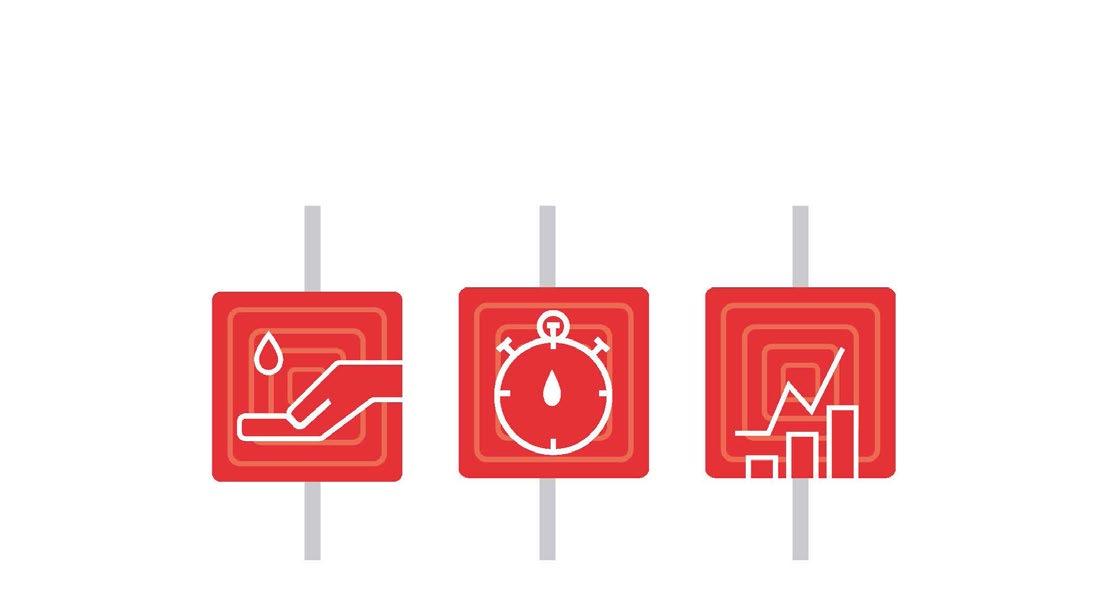
AMF Bakery Systems’ Spiral Conveyor incorporates the most sanitary design elements, including a patent-pending monopiece cage bar, for efficient cleaning and maintenance. Equipped with plastic modular belting using the Intralox DirectDrive™ System, the Spiral Conveyor eliminates product movement on the belt to minimize potential jams. This custom-configured solution is suitable for a variety of product applications including intermediate dough proofing, product proofing, cooling, and freezing.
Your bakery is our world.
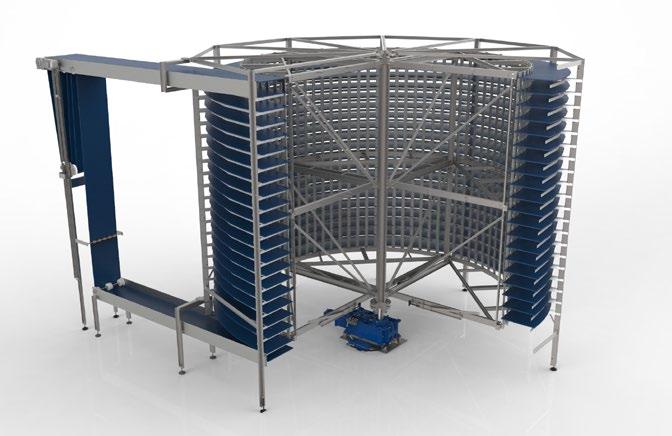
a markel food group company
AMF BAKERY SYSTEMS AT:
BAKERY, MOSCOW
&
COMPLETE BAKERY SOLUTIONS | AMFBAKERY.COM
VISIT
MODERN
FOOD
HOTEL ASIA, SINGAPORE BAKERY CHINA, SHANGHAI
Secondary virtues are in demand
Secondary virtues such as user-friendliness, hygiene, robustness and workplace safety are becoming increasingly important in bakery machine construction. Examples include Rademaker’s laminating and make-up lines.

+The fact that a line delivers the required product in the required quality, regardless of whether that is low or high, is taken for granted nowadays, or is even one of the knockout criteria. When making investment decisions, any baked goods supplier who must offer delivery reliability and cost leadership – and these criteria apply worldwide in view of the highly centralized sales structures in the retail trade and food service – will for his/her part look for quality, efficiency in the form of high availability, and possibly for flexibility as well if contract terms are not very long, and will calculate the ownership cost.
Fewer spare parts are only one item in this long list. However, even the most numerically obsessed will have realized by now that this is not purely a definition or calculation task, but in practice depends on many details, not least of which is the way the operators and cleaning staff cope with the plant. One can argue over whether this is due to the increasing scarcity of trained staff or whether those with the necessary skills prefer not to work in this or that bakery, but it is a fact that fewer professional personnel are available. This is equally true both in industrialized countries and in countries in which there is no structured training for baked goods production employees.
Rademaker’s development department in Culemborg, the Netherlands, now grown to 30 employees, has worked intensively on this development in the past few years. Results are impressive.
In the past, Rademaker’s Sigma laminating lines had 21 different drive systems, whereas today there are only eight separate drives. The cost of holding spare parts in stock is correspondingly less, and because they are all similarly built, the demands placed on the customer’s own technicians are lower. That’s only one example among many, since the plant constructor in the Netherlands already started reengineering its lamination and make-up technology years ago based on an extensive catalogue of criteria – in turn derived from experience gained through exchanges with customers.
As a rule individual processing units must be swapped when carrying out a product change on a make-up line for example. The items that need changing, and how that must take place, are now stored with the recipes in the controller, which tells the operator in simple, easily understandable images what needs doing and where. The exact positions where a tool belongs are displayed, and can be aligned to markings on the line’s frame. The direction of movement is also identified if necessary. All the fastenings that need to be loosened to make the change are the same and are easy to release, and conversely each newly-installed part must first of all be correctly positioned before it can start operating. For example, several folding shoes can be preset by just a few movements. These folding shoes can be removed from the shaft for a new product that uses fewer tools.
When mechanically repositioning a tool, e.g. a gap, a row of holes into which the lever must engage provides additional
www.bakingbiscuit.com 06/2018 PRODUCTION 42
++ Conveyor belt reversing rollers no longer have fixed mountings, but instead can be released and removed with two hand movements. That also allows the area behind them to be cleaned
© Rademaker
security, instead of just displaying the tool’s position on the screen. Optional sensor technology can also be installed to verify all these changes, but according to Rademaker’s R&D Manager Jan van de Grift, it is first of all “a question of taking the first step, namely making tool spacings reproducible and reducing error rates, which are not necessarily made intentionally but do cost time and money.”
The fact that tools, e.g. guillotines, hackers or punches, are pulled sideways from their positions and put to one side instead of being lifted above the line by two employees as in the past, is more for the benefit of user friendliness and occupational safety. Once they have been pulled out sideways, they can be carried away or put down on a tool trolley provided for the purpose. The general rule in all of this is that individual components weigh no more than is actually necessary for robustness and the slightly inappropriate handling that may also occasionally occur.
The avoidance of errors also applies to hygiene. The fact that base-frame edges are rounded, surfaces are dirt-repellent and slope so neither dirt nor water can collect there, and plant feet are no longer designed as dirt-traps, has been


state-of-the-art in the meat processing industry for many years, and so has full wet cleanability. Such requirements are also increasingly a part of the standard catalog of an invitation to tender in the baking sector.
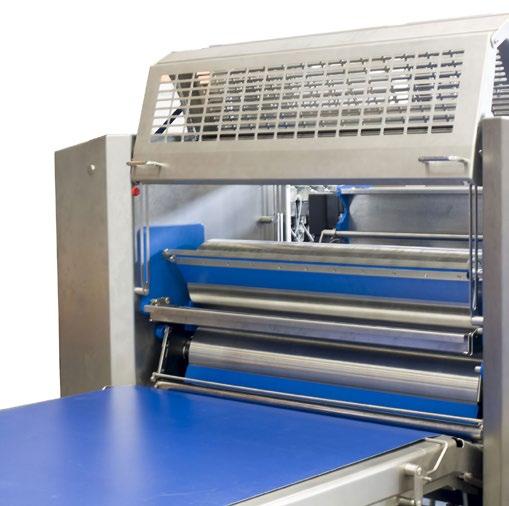


Rademaker has refined other details. Conveyor belt return rollers, for example, no longer have fixed mountings, but instead can be released with two hand movements and are removable to allow cleaning to take place behind them. Likewise, the panels under the belts can be lifted and removed, and are clearly marked to avoid the need for a lot of thought afterwards as to which belongs where.
There are also detailed instruction videos on the operator’s screen, of course, and not only must the recommended cleaning sequence be checked off, but also documented by this acknowledgement, with a time-stamp to enable cleaning intervals to be monitored. The fact that drive chains have been replaced by easy-to-clean toothed belts, and the bearings have permanent lifetime lubrication, helps in this respect. In any event, food safety and sustainability through the choice of materials have distinctly greater importance nowadays, because they also co-determine plant availability and costs. +++

43 PRODUCTION
++ The covers open vertically, requiring the application of considerably less force by the operators
© Rademaker
++ All implements can be exchanged easily without tools
Breakfast in Washington D.C. • Read the whole story on • backweltblog.com ADVERTISEMENT
© Rademaker
Private labels have big shares
The 2018 Annual International Private Label Yearbook has been published. The figures are compiled by the Private Label Manufacturer's Association (PLMA) based on Nielsen figures.
+Unfortunately it does not use the same merchandise group structure for all countries. Therefore the figures have only limited comparability across national frontiers. For this reason we will content ourselves with special countryspecific features.
In Germany, for example, the market share held by private labels in the frozen baguettes product range in volume terms dropped from 54.8% to 41.9%, which is still a 12.9% fall. In value terms, the market share decreased from 50.4% to 38.7%, an almost equivalent decline of 11.7%. On the other hand, although private labels as a proportion of the total frozen baked goods market reduced by 3% to 50.2%, in value terms private labels rose from 37.7% to 38.5%, showing that there has been a reversal of weighting here. The figures do not reveal, however, whether this is based on a rise in prices or also in the qualities of the private brands. In the range of breads and bread rolls not sold frozen, the PLMA claimed a private labels market share of 78.7% in volume terms for 2017, or 72.7% in value terms.
Frozen baked goods in Finland also developed very considerable dynamism in the past few years. According to the PLMA, the market share in volume terms in 2013 was 42.6%, compared to 53.5% in 2017 (+10.9%). The overall result in value terms looks even better. On this basis, the market share in the frozen baked products segment grew from 32.0% to 45.1% between 2013 and 2017, which is a 13.1% rise.
The market share held by private labels in the frozen fine pastries area in France, in both volume and value terms, is 70.9%. However, the private labels volume share two years ago was 81.8% and the proportion in value terms was only 66.8%.
The own brand retail in the Netherlands, especially in the chilled cakes and baked goods segment, was successful, and that also applied with regard to pushing through higher prices per kilo. In volume terms the market share plunged from 74.5% to 67.2% although it grew in value terms from 78.7% to 80.9%.
A different trend can be gleaned from the PLMA figures in Austria, where the private labels share of the frozen baked
products segment more than halved in the four years from 2013 to 2017, and according to the PLMA it dropped from 70.9% to the current 34.3%. The collapse was similarly drastic in value terms, where the private label market share sank from 49.4% to 17.9%.
There was a sharp drop in private label market shares for fine pastries in sunny Spain. In volume terms it declined from 70.3% to 51.9% between 2013 and 2017, and from 66.1% to 42.8% in value terms. For bread rolls and croissants, on the other hand, the Spanish food retail is almost a safe bank. Market shares in volume terms were about 80% and in value terms around 70%.
For the Czech Republic, the PLMA reports a rise in the market shares of private labels in the bread segment from 2013 to 2016 (2017 figures are not yet available) from 19.1% to 30.2% in volume terms, and in value terms from 13.9% to 28.3%. Incidentally, according to the PLMA, one third of the sales of Mexican bread rolls in the Czech Republic is attributable to private labels. Indeed, at 46.2% it equaled almost half in volume terms.
The United Kingdom is a true citadel of private labels in many product ranges, albeit the changes have been rather small for years, and sometimes there are almost bizarre differences. Thus the private label share for large sponge cake rolls is 87.3% in volume terms, and as much as 88.2% in value terms. For small sponge cake rolls the figures in quantity terms are only 29.7% and 23.8% respectively. It’s quite obvious that either the British or the British trading houses discriminate against small cakes. In the case of packed cakes, sub-category: large whole cakes, 81.5% of all packs bore the supermarket’s own label in 2017, whereas for packed cakes: small whole cakes, only 45.8% were allowed to do so, and packed: single pieces, less than one pack in four (24.3%) carried the logo. 95.8% of gateaux, cakes and fruit cakes with a short shelf life carry the logo of the retail company that sells them. Even Christmas plum puddings can’t compete with that. In volume terms they only reach 93.2%. But they account for 96.5% of sales of this “Very British” Christmas specialty. +++
www.bakingbiscuit.com 06/2018 MARKET 44
Your Business Simplified with DirectDrive™ System

DirectDrive System spirals function the way spiral systems should function; with reduced belt tension, with improved product orientation, with increased load capability. This system eliminates overdrive and makes operation of your mission critical equipment reliably smooth, without interruption.
Technology like this isn’t a luxury. It’s a necessity.

Improved efficiency
Reliable performance
Reduced total cost of ownership
your solutions at intralox.com.
Find
Absolute artisan skill
The French bakery Artisan Boulangerie Jean-Marc et Cécile Pain convinces its customers with artisan skill, absolute freshness and German ovens.

A community with a population of around 9,900, six bakeries and two supermarkets – the Artisan Boulangerie Jean-Marc et Cécile Pain bakery relies on absolute artisan skill to stay in business in Dombasle-Sur-Meurthe near the city of Nancy in north-eastern France. This requires some of the total of 10 staff to get out of bed really early. Production starts around 02:30 a.m., and customers can buy the first baked products from 04:00 a.m. onwards. There are no long transport routes. The bakery’s only sales outlet is located directly at the bakehouse. The bakery’s opening hours are until 19:30 p.m. on six weekdays. Sunday is the only day when the ovens stay cold. The company bought an oven from the German oven builder DEBAG in Bautzen around two years ago. Master baker Jean-Marc compared and tested several ovens from different plant constructors. The expert finally decided on a Helios multi-deck oven. According to owner Jean-Marc: “The oven needed to fulfill my various specifications and wishes.” Thus primarily the result of baking had to be convincing, but the oven also needed to fit into an existing niche at the back of the saleroom, because that was where the baked goods were to be produced in front of the customers. The oven has stone plates and three decks, and is heated electrically. Explaining the oven’s merits, Master Baker Jean- Marc says: “I was also won over by the uniformity of the oven’s baking, and the fact that the temperature is held for a long time. The oven also heats up and reaches the
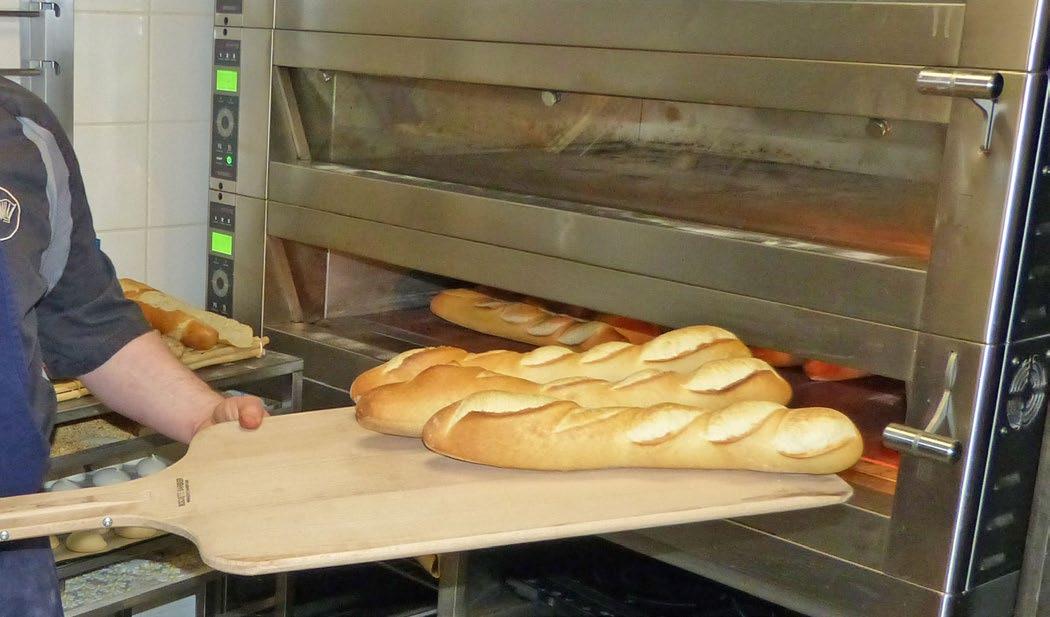
www.bakingbiscuit.com 06/2018
+
++ The DEBAG instore oven with a stone plate is available in various models. This allowed optimum use of the space available in the saleroom
© f2m © f2m PRODUCTION 46
++ Master baker Jean-Marc Pain with the “Tradition” baguette




























www.bakingbiscuit.com 06/2018 ADVERTISEMENT
Different variants of breads and baguettes are the main products ++ Croissants and other fine baked goods are produced by hand ++ Up to 1,000 baguettes are produced every day and baked-off in front of the customers © f2m © f2m © f2m 47 PRODUCTION Talking with the world about baking – in seven languages! Dictionary of Bakery Engineering and Technology Dictionary of Bakery Engineering and Technology Wörterbuch der Bäckereitechnik und -technologie Dictionnaire des termes techniques et technologiques pour la boulangerie Diccionario de ingeniería y tecnología para el sector de panadería y bollería Словарь по хлебопекарной технике и технологии Ordbog for bageriteknik og -teknologi English German French Spanish Russian Danish Japanese DEU ENG FRA SPA RUS DAN JPN Dictionary of Bakery Engineering and Technology www.foodmultimedia.de Hard copy, 336 pages, EUR 39 + handling/postage One industry –one dictionary f2m food multimedia gmbh usanova@foodmultimedia.de Phone +49(0)40 39 90 30 62 Fax +49(0)40 39 90 12 29 Or use the QR Code:
++
required temperature quickly, the upper and lower heating on the Helios can be regulated separately, and the controller is simple and easily understandable.”
Extensive product range
The oven’s high flexibility allows all the production unit’s baked goods to be baked. The bakery’s employees make around 100 different types of baked products, among which there are 25 kinds of bread. According to the bakery’s owner: “Bread and baguettes are our main revenue earners, and their quality must convince our customers on a daily basis.” That’s why the company depends not only on the instore oven with its stone plates, but also on its own wheat sourdough, e.g. for the “Tradition” baguette. This starts with kneading a wheat dough containing 1.8% salt for 15 minutes, after which it rests for 16 hours at 5°C. Make-up is done by hand. The “Tradition” baguette is then baked for 20 minutes
at 250°C – yielding a crisp baked product with a flaky crust and large surface area.
The staff produce between 750 and 1,000 baguettes per day, including/consisting of of which there are various different types, lengths and weights. The “Tradition” baguette, for example, weighs 250 g, is around 60 cm long and costs EUR 1.10.
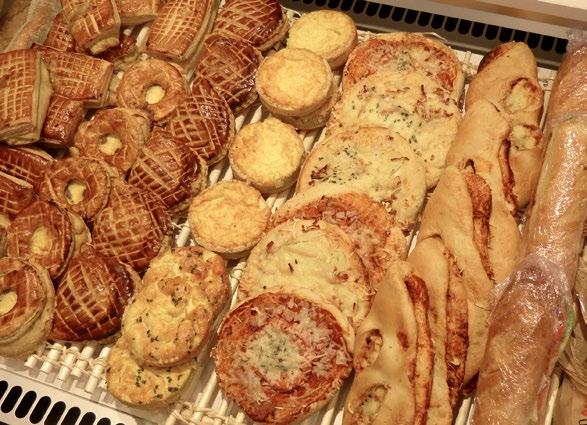

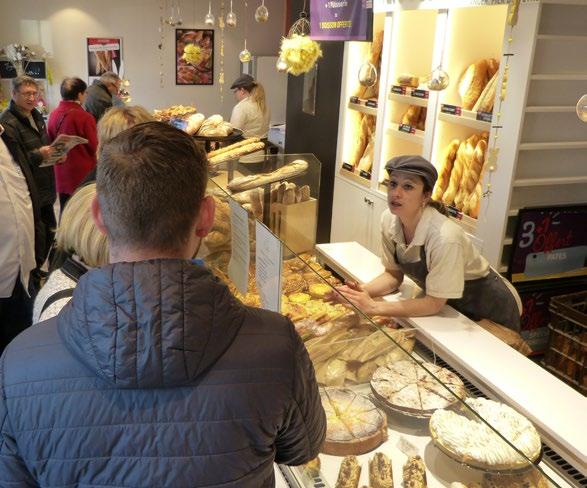
Since the baguettes are baked in front of the customers, master baker Jean-Marc also considered the oven’s ease of cleaning to be very important. This is ensured by the choice of stainless steel grade, and also by the fact that the glass panes are removable for cleaning. The concept and investment are a success for the bakery, and help the company to hold its ground in the market through absolute artisan skill. +++
More information about the bakery at: www.facebook.com/ pg/boulangeriepain/videos/?ref=page_internal

www.bakingbiscuit.com 06/2018 PRODUCTION 48
++ Although the branch is not located on a main thoroughfare, regular customers are not the only ones who find their way to the bakery, because the concept has got around by word of mouth
++ Various fine pastries in the sales outlet’s display
++ The sales outlet has an entrance and an exit – which is how the customer flow is managed
©
©
++ The bakery also offers spicy specialties
©
f2m
© f2m
f2m
f2m
Successful Partnerships



The Rademaker approach includes a close co-operation with the end user. We deploy decades of experience to develop the best possible process solutions. The customers’ boundary conditions with regard to ingredients and actual production environment are the basis for all tests run in the Rademaker Technology Centre. Our consistent focus on the customers’ requirements results in specific solutions aimed at the ultimate success of our customers in the market.




www.rademaker.com
Specialists in food processing equipment
New food culture trends

Every year for six years, futurologist Hanni Rützler has written a Food Report dealing with new trends in the nutrition market. In the latest Report, she and her co-author Wolfgang Reiter subdivide the future outlook into product trends, trends in communal catering, gastronomy and the food retail.

+In her introduction, Rützler writes that eating is increasingly becoming an expression of lifestyle, thus also bringing the sensory experience of product development and consumption center stage. One group want to know the producers and retailers, while the others want to cultivate and produce themselves. The demand is not for quantity and a wide variety but for choice and “curating the range on offer”, i.e. a preselection that unburdens con sumers’ consciences, to gether with inspira tions for a personal, tailor-made diet. Ac cording to Rützler, a “fundamental sys temic transformation” is currently taking place, “which manifests itself in the expanded F&B (Food & Beverages) sector from agriculture to the retail and its customers.”
Of course, Rützler still identifies the big food trends, but in contrast to previous years they are not individual prod ucts or raw materials making a name for themselves as superfood, but overarching themes such as Plant-Based Food, Transparency or Healthy Hedonism.
Plant-Based Food
Naturally, flexitarians, vegetarians and even vegans may also recognize themselves under this description, but Plant-Based Food is less a prescription and coercion, and more an appreciation of the value of vegetable raw materials that displays intelligence and enlightenment about their origin and preparation, as well as ethically and ecologically correct behavior. Simultaneously, and that makes it attractive for non-veggies as well, it enables a high level of discriminating enjoyment. Plant-Based Food is a trend that can be observed in the growing number of relevant cookery journals and books, and can also be found in top-class gastronomy.
The second strand in which the appreciation of vegetable raw materials can be discerned is the use of vegetable proteins in individually customized nutrition, or in products for this. Products based on legumes, algae, fungi, seeds and nuts provide high-quality proteins which many people have incorporated into their personal diet as being health-promoting. These products have exchanged their “healthy, but doesn’t taste very good” image for one that says “healthy and tasty”. Consumer interest in vegetable-based foods is growing, especially against the background of the large consumption of animal proteins in western and for their part highly controversial production conditions as well as their damaging health effect (cholesterol).
Transparency
Transparency, the second food trend spotted by Hanni Rützler, is by no means independent of the above. Rützler says: “Interest in safe foods and concern about their origin has developed into a perpetual topic in our eating culture.” This is in no sense only about chemicals in farming or medicines in animal husbandry, but about the ethical values used as a guideline along the process chain from raw materials to finished product and all the way to the consumer’s table. Anyone who wants to know precisely what, how, who and where, necessarily needs significantly more information than has been available hitherto. Success in the food market in future will also depend on how much transparency is supplied, and how credible the supplier is in this respect. Information transfer via data, the Internet and social media makes it easier to obtain information, but also easier to spread disinformation. That’s why transparency on its own is not the decisive factor, and a basis of trust, both rational and emotional, is needed in parallel. Life will be simpler for local
www.bakingbiscuit.com 06/2018 MARKET 50
© kostman –www.123rf.com
++ Legumes are regarded as ideal sources of protein
++ Hanni Rützler and Wolfgang Reiter © Rützler
suppliers than for national or global ones in this respect, because they can demonstrate their message and are available to answer questions. But communication and transparency can also be used in other ways as a basis for creating trust. Rützler says: “Whether and how quickly the transparency trend will gain acceptance, and not just in niche markets served by young start-ups, will decide how consumers use their newfound powers in everyday shopping.”
Healthy Hedonism
A healthy diet is important, and the majority of consumers would put their name to that at any time. Problems arise only when we try to define what is meant by healthy. And real difficulties arise when one also attempts to implement it, because according to an Allensbach study, nearly 60% of Germans say enjoying life and having a lot of fun is especially important. Slowly but surely, however, the opposing concepts of healthy and enjoyable seem to be coalescing. That may have something to do with the fact that healthy doesn’t always demand asceticism, but also offers enjoyment. Good and healthy is attractive, whether it’s from a food truck or a farmer’s market, only not prescribed with a sour-faced expression. Seen in that light, according to Rützler, the trend towards Healthy Hedonism is equivalent to a culinary liberation.
Nouvelle canteen
According to Rützler, appreciating guests, stressing healthiness, most enjoyable and customized are the keywords that are in the process of revolutionizing the foods on offer in canteens, student refectories and other communal catering establishments, and have to some extent already done so. Company restaurants and coffee corners are part of the corporate profile nowadays, and are one component of what makes a company attractive to potential employees. What counts in that respect is taking care of the employees, communication, communal meals and relaxation breaks in stressful daily work, and no longer just supplying specified amounts of calories. That’s why firms are investing increasingly often in both a culinary and an aesthetic upgrade of their canteens, making them flexible in terms of time and placing value on social contacts,
communication and relaxation. Of course, this also includes a healthy, convincingly tasty menu. Some canteens nowadays are scarcely distinguishable from a good restaurant, and even self-service is no longer obligatory everywhere.
The motives are similar, although the ways are different. The American media company Bloomberg didn’t provide any canteen at all, nor any company restaurant in its new corporate headquarters in London. There is simply a “Communal Pantry Area” where drinks and snacks are available. CEO Michael Bloomberg says staff should leave the building in the midday break instead being addicted to their workplace, like some Google employees, because its furnishings are more comfortable and relaxing than their own home.
Gastronomy: echoes of French cuisine are en vogue

Old school French cuisine ekes out a rather marginal existence nowadays as a bolthole for affluent elderly gourmets. Young chefs from around the world have adopted its quality standards and awareness of freshness and details, while at the same time globalizing and spicing up the art of cooking. They also regard a focus on enjoyment as a life-skill, while at the same time not being ashamed of their ties to French cuisine. These chefs seek experience and invest time and affection in their search for raw materials and imaginative preparation.

51 MARKET www.bakingbiscuit.com 06/2018
KOENIG BACKMITTELGMBH & CO. KG • Postfach 1453 • D-59444 Werl Tel. 02922/9753-0 • Fax 02922/9753-99 E-Mail: info@koenig-backmittel.de • Internet: www.koenig-backmittel.de The Nut specialists Quality-brand and freshness with long tradition Almond- Hazelnut- and Peanut-Products, roasted, sliced, diced and slivered. Hazelnutfilling and Multi-Crunch. Please ask for products meeting your specifications. KOENIG Motiv4 NTS 91x53.qxd 12.02.2007 11:10 Uhr Seite 1 ADVERTISEMENT
©
++ Two slices of brioche with butter and fine preserve cost EUR 3.80, a café au lait to go with them is EUR 4.10, a croissant is EUR 2.50 and a fine almond cookie (tuiles aux amandes) costs EUR 0.70
f2m
++ A view into the bakery, with Rémi Soulier standing in the foreground
© f2m
An entirely similar trend is observable in the bakery scene. The French art of baking is highly rated, provided it is put into practice and not just paid lip service. The latest hot-spot in the Viennese baking landscape, Parémi at No. 10 Bäckergasse, is a good example of this. After their Matura (A-Level exams), Rémi Soulier and Patricia Petschenig took the road to Paris, where their plans included an in-depth study of the high art of baking and patisserie at the Ferrandi School of Culinary Arts and Hospitality Management. Back on the Danube, they have been putting what they learned into practice since October 2017. The flours for baguettes and breads originate from small French mills where milling also includes the wheatgerm. Their fat content and flavors enrich the taste of the breads, but they also perish quickly and thus demand care and control from the bakers. Doughs are prepared entirely by hand in the traditional way, and go directly from the oven into the shop. Artisan work is also the rule for laminating puff pastry and croissant doughs – using French butter of course. Windows around the corner provide a view into the bakery. By the way, goods are freshly baked on an as-needed basis, even in the late afternoon.
The guestroom accommodates around 30 seats, which are well filled regardless of whether it’s at breakfast time, at lunchtime when the emphasis is on filled baguettes and fougasses, or in the afternoon/early evening. The sales and service staff have a good workload, and demand is attracted especially by the fine patisserie works of art created lovingly by hand and with a great flair for decoration. On the other hand, the first bites are followed by enjoyment-filled silence.
A radical change in food retailing
Anyone wanting to buy food is spoilt for choice, over-thecounter or online, in a supermarket or farmer’s market, from Turks/Italians or directly from the producer, in a food temple with space-age furnishings or in a small, comfortable patisserie, organic or conventional, put it together yourself or haybox etc. The selection of shopping options has never been as diverse as it is nowadays, and is becoming ever bigger. Amazon and Google can see their marketing opportunities, whether or not they involve cooperating with over-the-counter retail. Selling through online shops is also feasible for manufacturers or startups, filling stations are upgrading themselves into little supermarkets including a catering offering, and even supermarkets and department stores have discovered that catering offerings bring footfall.
The only problem is that contacts on the consumer side are no longer so clearly identifiable. Stay-at-home mothers who do all the shopping are a discontinued item, whereas modern families organize the provisioning decisions and work more democratically, which also involves frequent changes in the family member who is responsible. On top of that is the steady rise in the number of single-person households, which ceased long ago to be a minority element and is now an economic factor to be taken seriously. The more of them there are, the more diversified are their requirements and needs. Rützler’s conclusion: “Old-style shopping is dying, but the new is still
++ Cookboxes supply everything that is needed, accurate to the gram and without any remnants. The recipe and instructions are available in print or online, and anyone who wants it can have a doorstep delivery of all the purchasesHause liefern
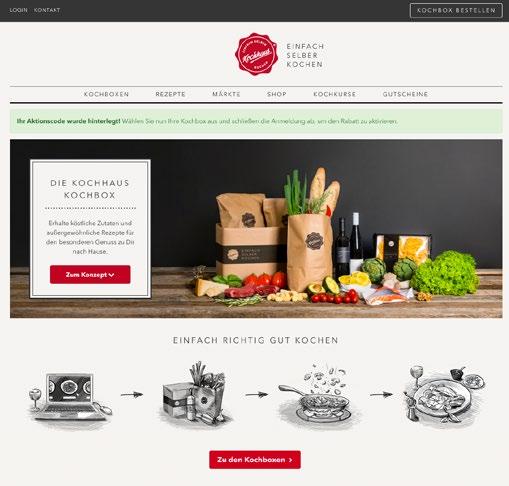
unborn.” In her opinion, the future lies in a combination of digital and physical retailing, which is why not only is overthe-counter making inroads into the online market, but conversely online groups are elbowing into the over-the-counter market. Anyone who is accustomed to buy food for the evening and bring it home on the same day gains little from a next-day delivery. Online retailers who deliver what was ordered and also do so in high quality will win customers’ hearts, above all if their publicity show them to be remarkably generous. In the future, according to Rützler, a combination of the two plus customer satisfaction is what will secure customer loyalty, which will in turn be reflected in sales.
Conversely, Big Data is currently revolutionizing the retail world. Cleverly devised data acquisition and process control systems are bringing closer the aim of offering exactly the goods in exactly the right place, at precisely the right time, and at a price that motivates customers to buy. Checkouts trigger ordering processes, a stagnating outflow of goods reduces prices, and in the not too distant future robots will take care of shelf-stacking. The willingness of broad sections of the population to share their data as payment for service and discounts is increasingly bestowing opportunities on the retail trade to tailor its advertising to customers and to supply them with, for example, menu boxes containing exactly the right amounts of raw materials for a family menu or even to invite guests to a birthday party. This brave new world is supplemented by refrigerators that give timely warning when there’s not enough milk left, and talking aides that can answer the phone or place online orders. Which of these will win through in the end is still unclear, however, and it will probably also be a question of whether the all-decisive megatrend in the retail really happens at all, or whether the diversity of alternative supply options actually remains the future trend. +++
www.bakingbiscuit.com 06/2018 MARKET 52
ARTISANA won the iba award

RONDO is committed to innovation: To innovative machines and equipment. To innovative processes. To produce innovative products. From our innovations come your benefits. Our innovation is the foundation for your success. www.rondo-online.com

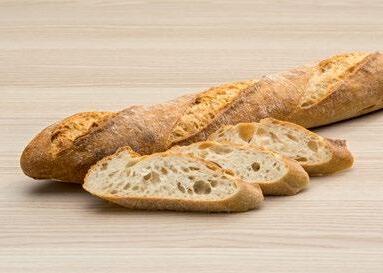
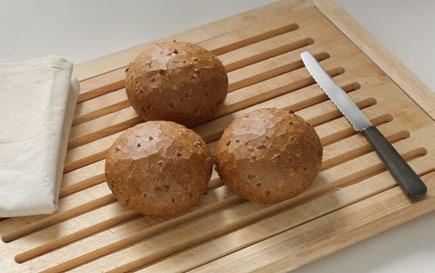


RONDO Burgdorf AG, 3400 Burgdorf, Switzerland, Tel. +41 (0)34 420 81 11, Fax +41 (0)34 420 81 99, info@rondo-online.com
Less flour dust in the bakery
Low-dust release flours from GoodMills Innovation: a practical case study.


+Dusting dough pieces and surfaces with flour is an essential part of the production process in bakeries. Unfortunately, however, flour dust causes problems for machinery, industrial hygiene and, last but not least, the respiratory tracts of employees. One solution is HT or “release” flour, as illustrated by the positive experience of Bäcker Lang Produktions GmbH.
Based in Freiberg, southern Germany, and with around 60 employees, Bäcker Lang produces high-quality bakery products for large customers and the 70 or so outlets of its parent company. The bakery has been using the HT flour TIP-TOP Ultra Clean Special from GoodMills Innovation (see info box) since 2016. After a successful two years, results show that Bäcker Lang now uses 80 percent less release flour during production, the dust exposure for employees has decreased, and time and money spent on cleaning have been significantly reduced.
Flour dust had become a problem
To prevent dough from sticking, every bakery has to routinely sprinkle surfaces and dough pieces with release flour or “dusting flour”. This is the only way to ensure efficient operation and is particularly important for semi-automatic and fully automatic production facilities where dough pieces pass through various stations, including work surfaces, proofing carriers or conveyor belts, before they reach the oven. If they stick at any point on their journey, production will be disrupted and, in the worst case, come to a halt. Master baker Heino Hambrecht is an occupational safety specialist at Bäcker Lang. He says: “Dusting flour was always a necessary evil for us. We used both German type 550 all-purpose flour and baker’s starch in our flour duster at the dough make-up line, as well as for our bread proofing baskets. Our bakers used a good 200 kilograms of dusting flour a day. When the sun shone into our production hall, all you could see were wafts of flour dust. This not only placed a great burden on
www.bakingbiscuit.com 06/2018 PRODUCTION 54
©
GoodMills Innovation
++ In comparison: On the left standard all-purpose flour, on the right TIP-TOP Ultra Clean
++ The person-related flour dust measurements of the BG before and after the line was converted demonstrated the fine dust reduction
the health of my colleagues, but it also meant an immense amount of cleaning.”
During his safety specialist training, master baker Hambrecht learned about the advantages of HT flours and decided to test TIP-TOP Ultra Clean Special in 2016. At the same time, the determination of airborne particles performed by the German Employer’s Liability Insurance Association (BG) revealed high levels of harmful respirable dust – one of the

What is HT flour?
HT flours such as TIP-TOP Ultra Clean are hydrothermally pre-treated flours. In this physical process the particles agglomerate so that the flour generates less dust while improving its release properties. Its special particle size means that the respirable dust content of TIP-TOP Ultra Clean is reduced to a minimum. Respirable dust is the fine dust that can penetrate into the smallest air sacs of the lungs, the alveoli, and accumulate there. To be specific: Compared with German Type 550 wheat flour, the respirable dust load of TIP-TOP Ultra Clean is 80 percent lower, as confirmed in test series carried out by the German Institute for Grain Processing (IGV).
The refining process used in the production of TIPTOP Ultra Clean also stops the activity of the flour’s intrinsic enzymes and thus virtually eliminates the allergenic properties of the native wheat protein. This prevents skin irritation and allergies as well as the development of mould and mildew stains on processing equipment, such as proofing boards and conveyor belts.
++ No longer necessary after the changeover to TIP-TOP Ultra Clean Special: dusting the bread baskets. The release flour from the production line is now sufficient, the breads do not stick
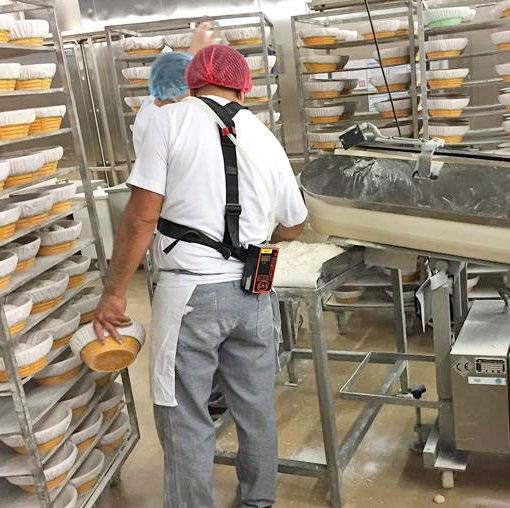
most frequent causes of baker’s asthma – in the Lang bakery’s ambient air. “Our dough management is based on a prolonged processing time and high hydration, which makes our doughs very soft and sticky,” explains Hambrecht. “This produces a particularly moist bread for the consumer, but it can only be made with a lot of dusting flour.”
In practice
In order to switch production at Bäcker Lang from conventional dusting flour to HT flour, the flour containers at the dough preparation line had to be emptied and the sieve inserts in the flour dusters had to be replaced. Using HT flour means reducing the mesh size from 3 mm to 1 mm. Heino Hambrecht comments: “This alone means that less flour, which could produce airborne flour particles, is introduced into the bakery.” When the line was converted in 2016, the equipment suppliers did not have HT-compatible sieves in their portfolio, so GoodMills Innovation made the inserts to measure for its customer. Today, sieves with small mesh sizes are a standard feature in many suppliers’ latest models, and older equipment can be adapted or modified with minor modifications.
On the first day of testing at Bäcker Lang, a consultant from the Hamburg grain expert explained in detail how TIP-TOP Ultra Clean Special should be used. “Previously, we didn’t just use dusting flour in our production line,” says Heino Hambrecht. “The proofing baskets into which the bread dough pieces fall at the end of the process were also covered with cloths and generously dusted. This is how we made sure that the bread could be easily removed from the baskets immediately before reaching the oven.” Now that the company is using HT flour, however, the release flour from the flour duster is sufficient: The cloths do not require additional
55 PRODUCTION www.bakingbiscuit.com 06/2018
© Bäcker Lang Produktions GmbH
© Bäcker Lang Produktions GmbH
dusting. “At first, our bakers were extremely sceptical. But, in fact, the bread did not stick to the cloths, even when we used them so often that they were noticeably damp.” On the very first day of using TIP-TOP Ultra Clean, the bakers were able to reduce the amount of dusting flour required from 200 to 75 kilograms.
In addition, the special flour scored with its excellent release results with minimal dust generation. After a short time, a clear reduction in airborne dust load inside the bakery was visible – with noticeable benefits for employees. Since they began using it, the bakers have been able to further reduce the amount of TIP-TOP Ultra Clean Special used in production to only around 40 kilograms per day.
Flour dust measurements of the German Employer’s Liability Insurance Association (BG):
Particulate fine dust content per cubic metre of ambient air
November 2016 September 2017
Person-related: 18.3 mg/m 3 3.6 mg/m 3
Stationary: 3.3 mg/m 3 1.15 mg/m 3
Convincing cost-benefit calculation
Using TIP-TOP Ultra Clean Special has paid off for Bäcker Lang Produktions GmbH. “Many bakers are put off by the three to four times higher price of HT flours,” says Heino Hambrecht. “But since we now use up to 80 percent less release flour, this quickly balances out.” In addition, according to the master baker from Freiberg, there are long-term cost savings that are less concrete to quantify – for example, when it
comes to industrial hygiene. Before the changeover, Bäcker Lang employees had to sweep the floor of their production hall up to five times a day. Now they do so only once. The cleaning intervals for the strip lights above the make-up line and for the surfaces of the proofers have also been extended from two weeks to two months. The hydrothermal pre-treatment of TIP-TOP Ultra Clean Special makes it significantly drier so that it does not attract pests such as moths.
For Heino Hambrecht, however, the most conclusive factor in the decision to keep using the GoodMills Innovation flour is that it makes the production facility safer for the staff and a more enjoyable place to work. Previously dust-intensive workstations such as the baguette divider can now be operated without the need to wear a breathing mask and are even safe for those who are allergic to flour. “If using this flour means that we can keep employees who, for example, were no longer able to work at the age of 55 due to pneumoconiosis, healthy until retirement age, this is by far the greatest benefit,” he concludes. +++
TIP-TOP Ultra Clean / TIP TOP Ultra Clean Special (depending on the machine model):
Benefits at a glance
+ Prevention of baker’s asthma and improvement of ambient air
+ Lower consumption of release flour
+ Reduced cleaning requirements
+ Prevention of mould and mildew
+ Pest control
According to Mintel, in 2019 and beyond, the global consumer landscape will evolve like never before, driven by themes of privacy, individuality, wellness, convenience and connectivity.
1 Total wellbeing – Consumers are treating their bodies like an ecosystem and seeking solutions that complement their personal health and evolving needs. Simon Moriarty, Director of Trends EMEA: “In 2019 and beyond, growing consumer curiosity with the microbiome shows no signs of abating. From gut-friendly fermented foods to probiotic skincare, consumers will demand products that balance and boost the natural bacteria found in and on the body.”
2 Challenge accepted – A growing momentum to take on new challenges is driving consumers to reach new heights and uncover new passions.
3 Rethink plastic – While not inherently bad, the throwaway use of plastic is driving consumers to review their own behaviours to prevent plastic pollution.

4 On display – Consumers and brands are becoming more aware that they have a digital persona to nurture and grow, creating a tension as everyone fights for attention and nobody is safe from scrutiny.
5 Social isolation – Constant digital connectivity, where physical interactions are replaced with digital updates, can increase feelings of loneliness, social isolation and depression, creating a demand for products and services that help consumers learn to disconnect.
6 Redefinning dulthood – The concept of what it means to be an adult has changed beyond recognition and consumers are adapting to lives that don’t fit the mould. +++
www.bakingbiscuit.com 06/2018 PRODUCTION/NEWS 56
© serezniy –123rf.com ++
Six key consumer trends

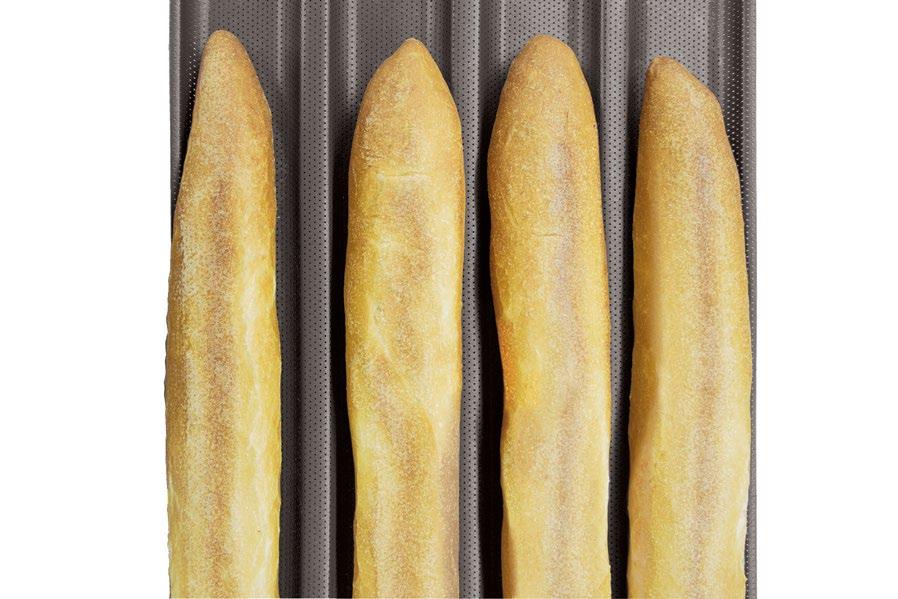

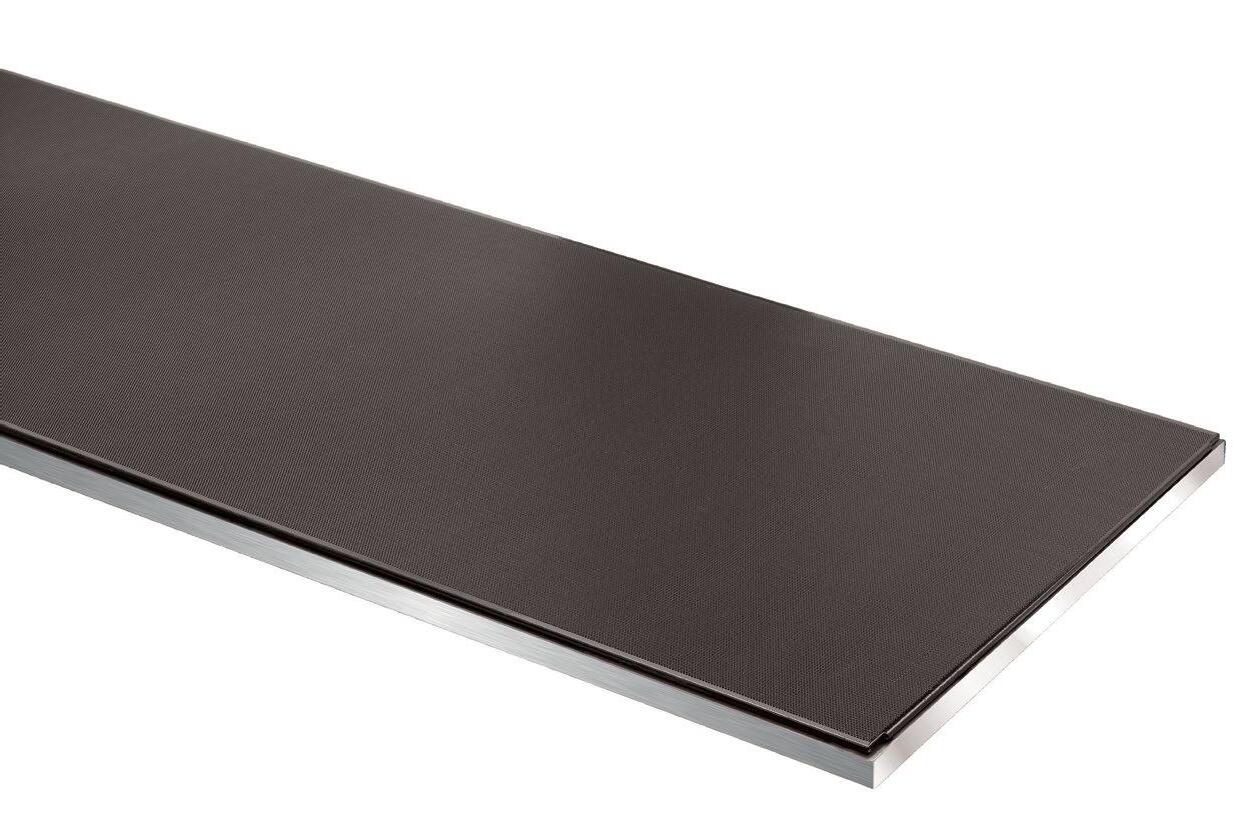

MORE THAN JUST A TRAY... SPECIALIST THE EXPERTISE OF A SPECIALIST IN THE FIELD OF NON-STICK COATINGS Silicone Elastomer PTFE / PFA / Ceramic Fluoropolymer commercial@diane-industries.com - +33 (0) 365 900 000 - +33 (0) 3 23 29 04 32 Z.I. le Champ du Roy - 8 rue Voltaire - 02000 LAON - FRANCE NEW NEW PERFORATION SPECIFIC PROFILE STONE PLATE BAKING RESULT The Food and Drug Administration
Fast, compact and flexible
Ishida Europe specializes in the fields of weighing, packaging, and quality control. The company is market launching a number of innovations in 2018.


+The “AirScan”, which inspects MAP (modified atmosphere) packages non-destructively for leaks, forms part of the "Quality Control" task area. The device detects leaks of 0.25 mm and larger in diameter at rates of up to 180 packages per minute. According to the company, the “AirScan” detects infrared vibrations from the escaping carbon dioxide and can be integrated into existing packaging lines.
The model ACP-700 Casepacker has recently been developed to pack bags into cartons. It is responsible for getting the cartons ready to be filled, inserting the bags and closing the cartons again. The system can process a large range of carton sizes and bag formats with widths ranging from 108 to 330 mm (including side-gusseted bags and flat bottom bags). Its output is up to 150 bags or up to 10 cartons per minute. Packing

Cooperation for snacks
Ishida Europe has signed a cooperation agreement with the US company Heat and Control, Inc. of Hayward, California, specifically for the snacks segment. Complete lines for processing, weighing, packaging and quality control are offered under the name “HCI Snack Solutions”. The two companies demonstrated the machines in operation at a joint Snacks-Open-House in Birmingham. +++
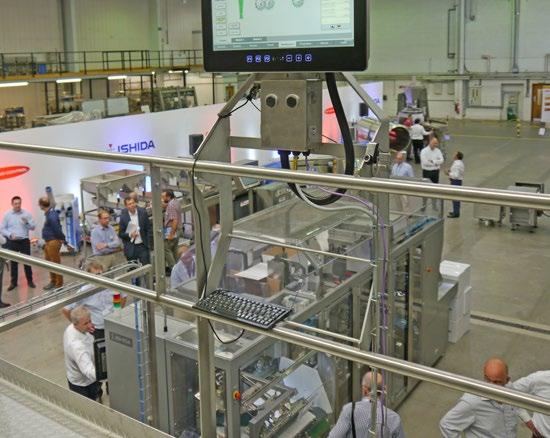
www.bakingbiscuit.com 06/2018 PACKAGING 58
©
++ Marketing Manager Torsten Giese explains the workings of the heat-sealed seam tester, which can be connected upstream of the Casepacker
f2m
© f2m
++ At the company headquarters in Birmingham: (from left to right) Marketing Director Steve Jones and Managing Director Dave Tiso (both of Ishida) with Bobby Kane, Director of Business Development of Heat and Control
++ At the Snacks-Open-House, visitors were shown systems for the complete production of snacks, including multihead weighers and form, fill and seal machines. This picture shows the Casepacker ACP-700
++ The new ACP-700 Casepacker packs bags into cartons in stand-up or side-pack patterns
© Ishida
patterns in stand-up and side pack format are possible. As Ishida demonstrated at a Snacks-Open-House in Birmingham, the system is easily accessible through doors that can be opened wide, which represents an advantage in cleaning and maintenance work. Another benefit is the footprint; according to the company, the model is the most compact of its type on the market.
The Casepacker can also communicate with an upstream Ishida sealed seam tester. The device not only checks the heat-sealed seam, but also the thickness and position of the bag and the distance between the packs.
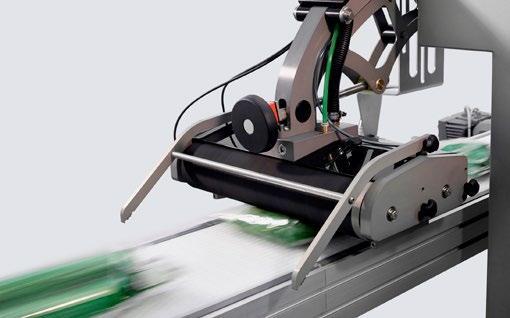
Another innovation is the vertical Inspira form-fill-seal (FFS) machine, which can pack either biscuits or crackers at rates of up to 250 bags per minute. This high speed, the company reports, is made possible by a new vacuum system for tensioning the film and optimizing the servo drive. In addition, a new sealing mechanism is used, which according to Ishida works with a far greater sealing pressure than conventional models and which thus produces high-quality heat-sealed seams. Another new feature is the large touchscreen panel to operate the machine easily. When designing the machine, attention was paid to good accessibility. All the relevant components are easily accessible in order to enable rapid product change and maintenance work without the need to use any tools. Ishida offers the “Inspira” in both intermittent and continuous versions. +++
Ishida Europe

Ishida Europe Ltd., based in Birmingham, England, was founded in 1985 and is run by Managing Director Dave Tiso. The company is a subsidiary of the Japanese Ishida Co Ltd. of Kyoto, which has production sites in Japan (Shiga), The UK (Birmingham and Poole), South Korea (Buchun City), China (Shanghai) and Brazil (São Paulo). The production program includes multihead weighers, tray sealers, as well as form, fill and seal machines, X-ray testing devices, checkweighers, case packers, seal testers and leak testers for modified atmosphere packaging (MAP).

 © Ishida
© Ishida
food processing packaging ingredients & raw materials refrigeration technologies shopfitting cleaning & hygiene service 25 Years in Russia XXV International Trade Fair for Bakery and Confectionary Moscow, IEC “Expocentre”, pav. 7, pav. “Forum” e-mail: modernbakery@russia.messefrankfurt.com, tel.: +7 (495) 649-87-75 Get a gift by secret word MODERNBAKERY 200+ exhibitors 66% Top-managers 16 000+ visitors 25 countries ADVERTISEMENT 59 PACKAGING
++ The AirScan inline system detects leaks in MAP packages
Good planning is half the battle
Product planning systems offer more flexibility and cut costs for the bread and bakery industry. Systems that are directly integrated in the ERP software are most suitable.
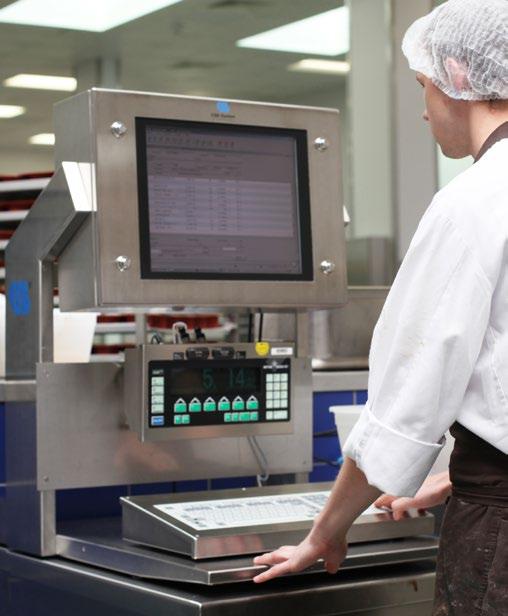
+Top quality, guaranteed freshness, just-in-time delivery –and all of this at a favorable price. The customers of bread and baked goods producers are quite demanding. Production processes are becoming ever more complex, as consumers ask for a wide variety of products with different flavors, ingredients and packaging. In addition, the time between order entry and delivery is getting shorter and shorter. What's more, urgent orders often have to be squeezed in. Trade in particular expects that even short-term orders are delivered on time.
This is when things start to get hectic: Which order must be completed first? Is there enough raw material? How long will the packaging lines be running? It goes without saying that in such situations, in light of proliferating variants as well as increasing production volumes, hardly any human would be able to keep track.
All areas must be included
Traditional planning tools also have difficulties in balancing the effects of short-notice shifts or unplanned machine and system downtimes. This often results in an inaccurate overall picture that ultimately leads to inefficiencies, high costs and reduced delivery reliability.
IT-aided production planning and control systems developed specifically for the bread and bakery products sector are more precise and yet more flexible. Ideally, enterprises do not use stand-alone solutions, but a program integrated in their ERP system. Only the ERP system as a data turntable is capable of seamlessly incorporating all key company areas like procurement, inventory management, coverage planning and sales as well as the production defaults and the single production areas in the planning process. Other important criteria that a production planning system must meet:
+ It ensures that raw materials, auxiliary supplies and operating materials are planned optimally and that the right raw materials are supplied with the right quality at the right time and at the right machines.
+ The system facilitates high-level planning and detail planning.
+ It plans the optimal production sequence so the orders are produced in such a way that the required set-up times are reduced to a minimum. This is particularly important in companies with many products. The important influencing factors for sequence planning are ingredients (allergens/ GMO) as well as operational requirements. The sequences are default values that should be easily changeable, and the impacts on the production process should be identifiable immediately.
+ The system must have flexible tools so it can fit in short-notice changes appropriately.
+ It must be possible to deploy the system in small and large-scale planning environments.
+ It ensures a constant high-capacity utilization at all manufacturing levels and in the individual departments. This will prevent overtime hours in one department, while the staff in another department is not working at full capacity.
+ Maintenance orders must be considered in the planning too.
+ It optimizes the internal inventory management.
+ It must be adjustable to the planners and their way of working.
Software orchestrates the production
Besides these “must-haves”, it is vital that the software provides several planning scenarios. Only then can it orchestrate the production in an optimal manner while leaving sufficient flexibility for the planners.
For example, production planning in the CSB-System supplies long-term, mid-term and short-term planning scenarios. This highly flexible planning tool enables to schedule, organize and control all production resources like man, machine and material, in an optimal manner even in difficult conditions caused by volatile order behavior and a vast variety of units. This secures the required freshness, optimal utilization of machine capacities and a higher throughput speed – and maximum delivery readiness. A customizable planning matrix presents a clearly structured overview of relevant information
www.bakingbiscuit.com 06/2018 PRODUCT PLANNING 60
©
CSB-System
such as orders, available quantities, bills of materials, restrictions and procedures linked with time dimensions. Be it longterm, mid-term or short-term: planning is always based on the same program. Usually, the process has three stages: First, the planning matrix is established. The planner or materials requirement planner can then revise the calculated production quantity. After that, the production plan is prepared for the next stages in the planning process. Every company defines itself, usually on product group basis, what it considers as long-term, mid-term or short-term production planning. The important thing is that the planner is supported with every time horizon.
Long-term planning
The production plan is established at a yearly, quarterly or monthly level, based on the statistical sales data. It is supplemented with the budget values and the liquidity planning based on that. Long-term planning is based on the order forecast and the resulting capacity utilization. The sales data for all customers in a year-on-year comparison are incorporated in the long-term production planning. The information derived from that can be applied for liquidity planning and framework agreements with vendors. Long-term planning also helps with strategical investment decisions, for example, when it comes to buying new machines.
Mid-term planning
This is about required raw materials, with the right quantity and the right quality, being actually available in the operation at time X. Mid-term planning is based on the plan values of long-term planning and is created for instance on week level. The planned capacities are aligned with the available capacities, and a production and process plan is calculated. The capacity and demand-oriented production and machine allocation plan lists the requirements for material, man and machines for the requested periods. The optimized recipes for the complete weekly production plan are taken into account in the procurement optimization in order to reduce material costs.
Short-term planning
Short-term planning considers the results of the two previous planning stages and supplements planning with operational data from the ERP system and from intralogistics. The decisive question here is, how do I produce my orders with maximum utilization rate and with the minimum use of resources?
Production order management converts the planning results into production orders. Procurement and sales orders as well as inventory data are incorporated online. The processoptimized machine and line allocation is predefined, and the production progress can be monitored in real time at the control station. Maintenance and trouble management is integrated.
Dependencies become transparent - and costs are reduced
At the end of the planning process, only a few questions remain unanswered: The production orders are distributed automatically to the machines and lines in production and

packaging, the staff is assigned automatically in accordance with qualification and availability. So the perfect plan then? No, because basically it doesn’t exist: public holidays, campaigns and finally the weather have a huge influence on sales, and thus directly on production planning.
In that case, it is good if the software not only includes historic data, but is flexible enough to modify planning. One of the biggest advantages of CSB-Production Planning is that it visualizes dependencies, which may be related to the manufacturing method, the utilized machine capacities, the staff or the products as such. A possible under or excess coverage as well as production delays can be identified quickly so that production management can take corrective actions in time. As a result, overtime work of the staff can be reduced, set-up times and unproductive times are minimized, and costs are cut substantially.
But has everything been completed as planned?
Good planning is half the battle, as the saying goes. However, even the best plan isn't worth a thing if it is not followed. It is therefore highly recommended to organize production planning in combination with automated data capture. This is the only way for the persons in charge to get reliable feedback in the form of target-actual comparisons – be it in their office or on the move. Using real-time production monitoring, they can intervene quickly and take control. It also gives them important insights, for instance to optimize manufacturing processes in the long term, to make processes more efficient and to reduce rejects. In the future, that much is certain, it will be essential to produce more while consuming less. +++
Author: Timo Schaffrath, CSB-System AG
61 PRODUCT PLANNING www.bakingbiscuit.com 06/2018 © CSB-System
++ Barry Callebaut to acquire Inforum in Russia
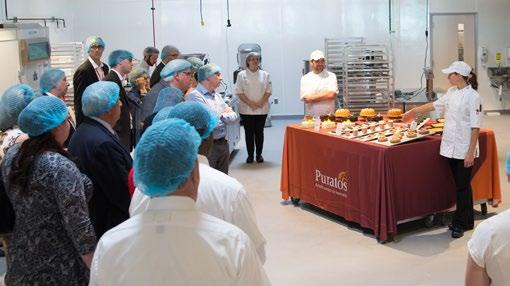
The Barry Callebaut Group has signed an agreement to acquire Inforum, a leading Russian B2B producer of chocolate, coatings and fillings. Inforum was founded in 1989 by four entrepreneurs. The company started its business selling cocoa products. Sales revenue in 2017 was about RUB 5.1 billion (EUR 77 million). The company operates a production site in Kasimov, Ryazan Oblast (285 km southeast of Moscow) and employs more than 300 people, who will transfer to Barry Callebaut upon completion of the transaction.
After importing industrial and specialty chocolates to Russia since the late 1990’s, Barry Callebaut built a chocolate manufacturing plant in Chekhov, Moscow Oblast (60 km south of Moscow), which became operational in 2007, and also has a CHOCOLATE ACADEMY ™ center – a training center for professional users of chocolate – in Moscow. Barry Callebaut currently employs about 80 people in Russia. The acquisition of Inforum will enable the company to significantly expand its presence and manufacturing capacity in Russia, the world’s second largest chocolate confectionery market in volume terms. Russia is a traditional chocolate market and has a consumption of 4.8 kg per capita according to Euromonitor. Growth rates in volume terms are significantly above the global chocolate confectionery market according to Nielsen.
++ Not afraid to take chances
“Waste bread”, which could be translated as leftover bread or even scrap bread, is what the British bakery chain Gails calls a newly-developed bread. It is made by converting scrap bread into porridge, which usually means cereal boiled up with water. This mix is then added to the dough for a sourdough bread. Gails gays this gives the bread a succulent, stable crumb and a strong crust. It says the bread will also taste differently each day, because the composition of the scrap bread differs from one day to the next. The first breads of this type are available in a few Gails’ branches and will subsequently be available in all branches. Gails is selling the bread as a contribution to restricting food wastage, while simultaneously supporting more than 40 local charity organizations with unsold bread. Surplus Food or Food Waste is currently a major issue in Great Britain. We shall see what reception the bread receives among consumers. +++
++ Greggs with Click and Collect breakfast
Most people are not only in a hurry in the morning, but are also not very talkative. For such customers, and others, the British bakery chain Greggs (more than 1,400 branches throughout the British Isles) has now created an opportunity to obtain breakfast without saying a word. Initially, three Manchester shops are trialing a system to order over-thecounter breakfasts via an app. Customers can choose between sandwiches, baguettes, porridge, muesli, wraps, pastries and various specialty coffees. A new addition to the range is pumpkin-spice latte. Anyone who has ordered breakfast in this way via an app need only call in, pay and take away. The
company’s management chose the Manchester location because Greggs is said to have particularly loyal customers there. Incidentally, the chain also operates its delivery service for companies and private individuals in parts of Manchester and Newcastle. In Newcastle it also works through UberEats, for which the goods are then delivered by private vehicles.
++ Lesaffre takes over a baking agent manufacturer in Philadelphia
The internationally operating Lesaffre Group, originally from France and one of the three leading global yeast suppliers, has taken over Delavau Food Partners in Philadelphia. This expands Lesaffre’s presence in North America. Delavau is a specialist in baking agents based on enzymes and agents that assist in prolonging shelf life and reducing salt content. The areas of application range from pizzas and bred to cookies and cakes. The company also maintains a highly respected research and applications center close to Rudgers University in Central New Jersey near New York. Lesaffre was founded in France in 1853, and today it maintains 62 production sites worldwide, 51 sales subsidiaries, 38 baking centers and 5 culinary centers around the globe. It manufactures yeasts and fermentation products for the food industry, healthcare and biotechnology. The Group’s sales revenues exceed EUR 2 billion, of which more than 40% originates from emerging and developing countries. +++
The Puratos Group is continuing its expansion in the United States with the opening of its New Headquarters and Innovation Center in Pennsauken, New Jersey. Puratos Corporation has invested $10 million to create the, 23,700 square foot facility. The centerpiece of this expansion is the Innovation Center, which provides Puratos’ customers with access to the very latest industry equipment, expertise and training, as well as research into international trends. Puratos offers a range of products for artisans, industry, retailers and food service customers in the bakery, patisserie and chocolate sectors. The headquarters are located in Brussels/Belgium. In the US, the company is headquartered in Pennsauken, New Jersey and has 5 production sites. +++
www.bakingbiscuit.com 06/2018 NEWS ++ NEWS ++ NEWS 62
+++
+++
++ Puratos Group opens New Headquarters & Innovation Center
++ The Puratos Group opened its new headquarters and Innovation Center in Pennsauken, USA/New Jersey
© Puratos

Always keep the overview. We listen to the market. 6 print and digital issues p.a. Your connection to insights into: + Bakery technology + Market trends + Science and Research www.bakingbiscuit.com ©
buizinga


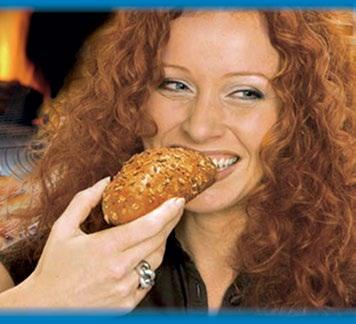

FROM SILO TO TRUCK
Kaak FPS | Kaak Bakeware | Benier | DrieM | Daub | MCS | LhotellierR2A | Multiparts
TurnKey Concept You bake, we care


























 Armin Juncker
Armin Juncker



























































































































































 BY READING BAKERY SYSTEMS
BY READING BAKERY SYSTEMS




































































































































 © Ishida
© Ishida







